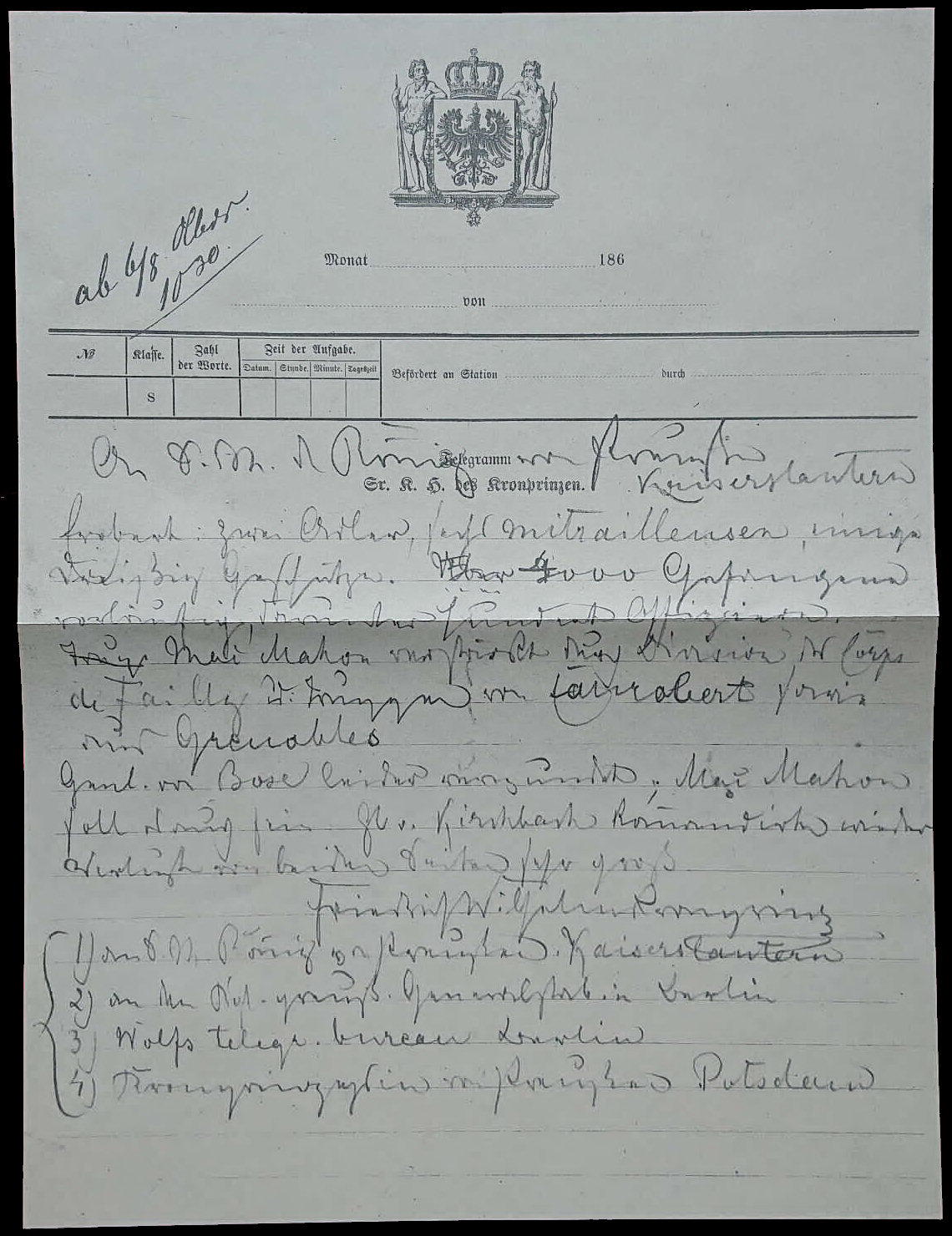| Up a level | ||||||||||
 |
 |
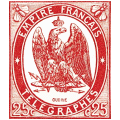 |
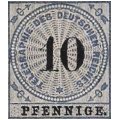 |
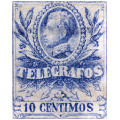 |
 |
 |
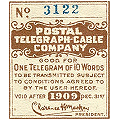 |
 |
 |
 |
| British | Canadian | French | German | Spanish | Portuguese | Netherlands | U.S.A. | Eastern | the rest | Contributions |
I have brought these prices up to date and added currency selection. I have used 'RH' numbers (Revised Hiscocks) for new designations to avoid confusion. CheckList Setup |
I have a lot of German telegraph forms. I decided it was best to put them on this separate page. . |
German Telegraph Forms.
| Shortcuts to other sections | |||||||||
| German Austria | Bavaria | Bavarian Envelopes | North German Confederation | Danzig | German Empire+ | Telegraph Dept. | DRGM | Envelopes | East Germany |
Prussia.
Registered 1873 ”Telegraphic dispatch" by express from Norden, Prussia to Dornum, Lower Saxony.


The stamps total 5½ Groschen. Interestingly, the pre-filled year on this is "186_"
Images courtesy of Heinrich Koehler Auktionshaus GmbH
A similar but later design Registered earlier, 25 July 1872. ”Telegraphic dispatch" by express from Berlin to Berlin.


The stamp is 2 Groschen. This held a telegram of the North German Confederation, it is shown there. Images courtesy of Heinrich Koehler Auktionshaus GmbH
A similar envelope used 3 April 1869 (despite the pencilled date). ”Telegraphic dispatch" but not registered or express, from Berlin. No stamps.
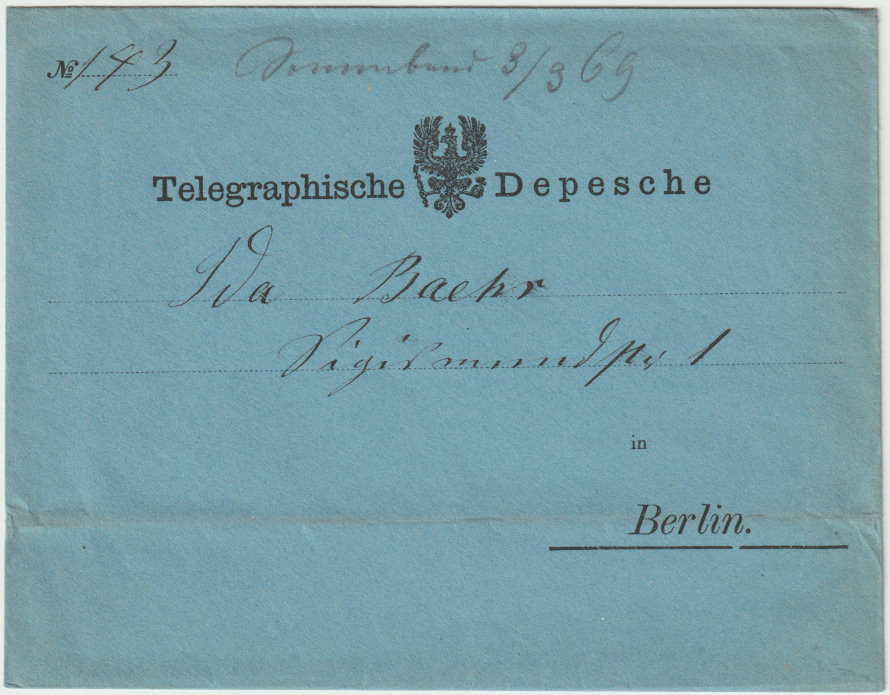
The contents are shown below under North German Confederation (No.143 of 1869). Image courtesy of Gabriel Coutinho de Gusmão.
Much of what became Germany started out as "German Austria" and Telegraph forms were headed as such.
1. German Austria.
Much of what became Germany started out as "German Austria" and Telegraph forms were headed as such.
The Austro-Prussian War of 1866 resulted in a win for Prussia and a loss for Austria, Bavaria, Saxony and Hanover.
As a result of the war, according to Britanica.com - 'the war was formally concluded on August 23 by the Treaty of Prague.
The treaty assigned Schleswig-Holstein to Prussia. The latter also annexed Hanover, Hesse-Kassel, Nassau, and Frankfurt outright,
thus acquiring the territory that had separated the eastern and the western parts of the Prussian state.
By the Peace of Vienna (October 3, 1866) Austria ceded Venetia for transfer to Italy. Prussia’s victory in the war enabled it to organize the North German Confederation.'
This was used in 1854. The name of the (K.K.) station is written 3 times, but I cannot understand it.

Used in Klausenburg 25 March 1860.

The imprint at the bottom says "Telegraphen-Drucksorte Nr. 28." (Telegraph Printing Type)
![]()
Image courtesy of Auktionshaus Klüttermann GmbH
Used in Stettin in 1867, then under Prussian control.

The bottom has an imprint showing the form was printed in Stetin. This image is from eBay item 164260424475 of September 2020 which is now deleted.
If you are the seller (or buyer) please contact me.
A telegram headed as German Austria used in Munich on 25 July 1866
The heading reflects that. There is a large image of the Bavarian Coat of Arms underneath.
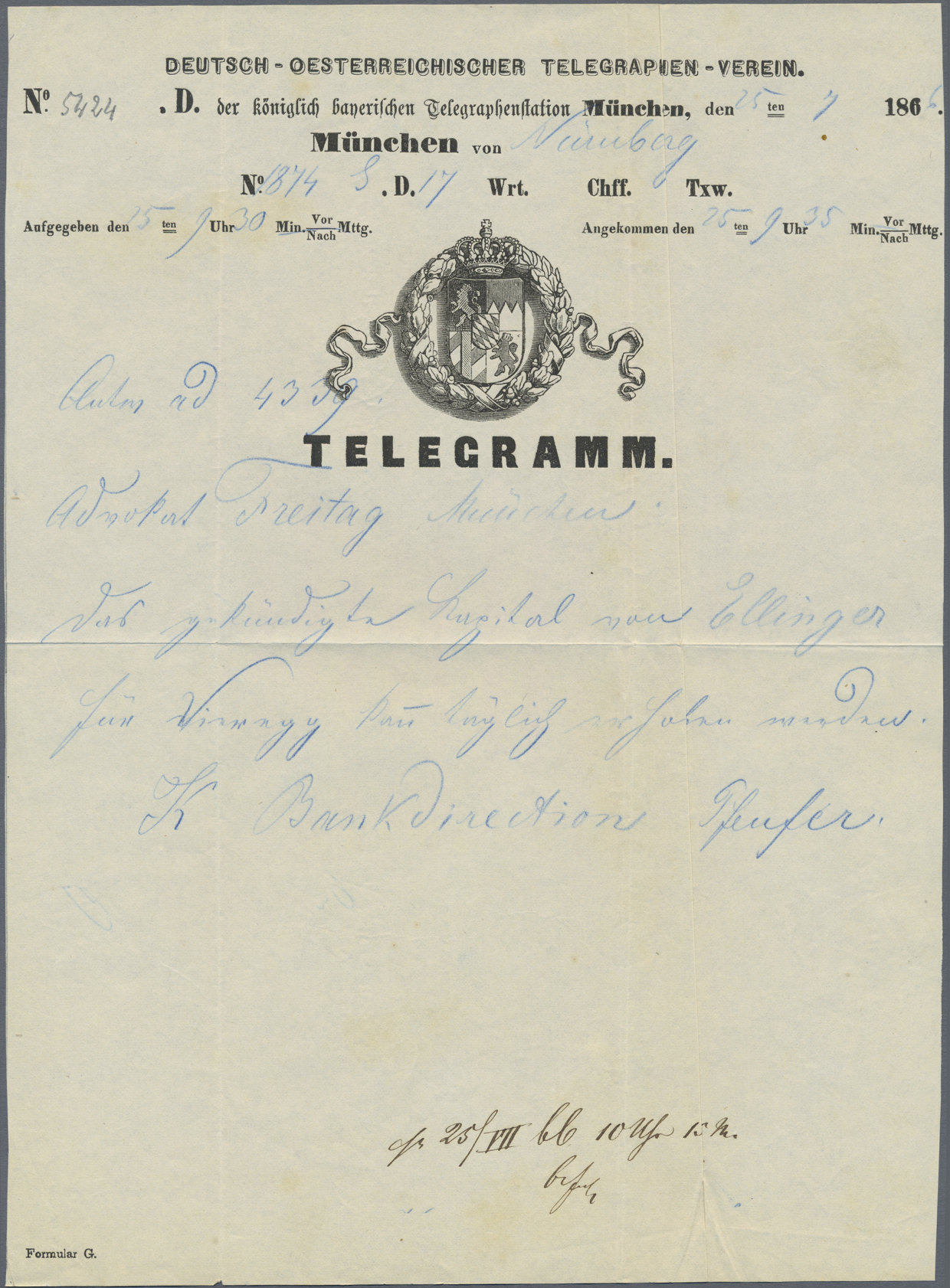
"Formular G." at bottom-left.
A telegram headed as German Austria used in 1871?
This is very similar to the last, but the year is pre-filled as "187" rather than "186".

This appears to have been cut short. Image courtesy of Rolf Lamprecht.
2. Bavaria.
There is an image of the Bavarian Coat of Arms at the top. This is dated 24 October 1855.
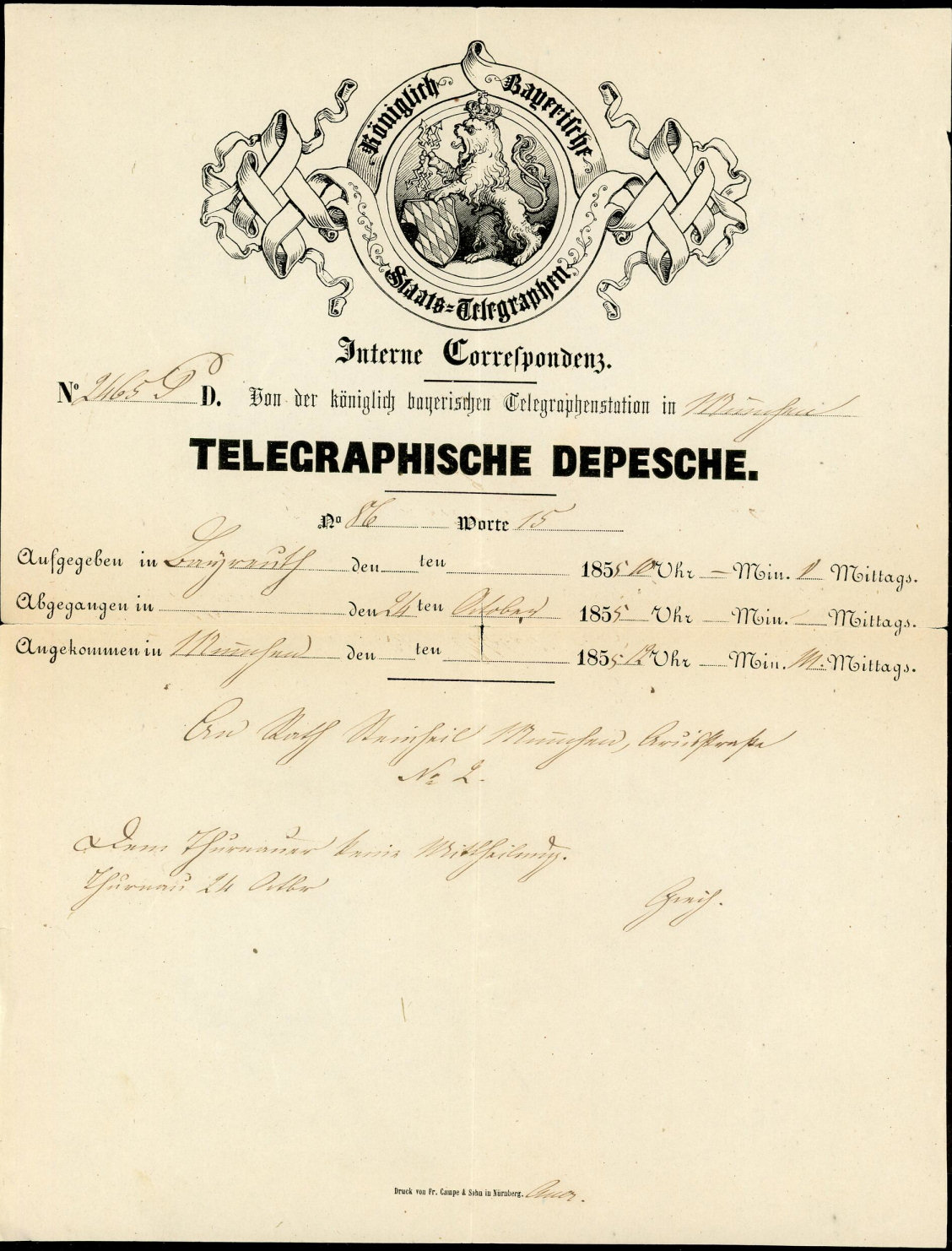
The imprint says it was printed by Fr. Campe & Son in Nürnberg.

Image courtesy of Auktionshaus Klüttermann GmbH
This has the Bavarian Coat of Arms at the top. This is dated 1 September 1878.
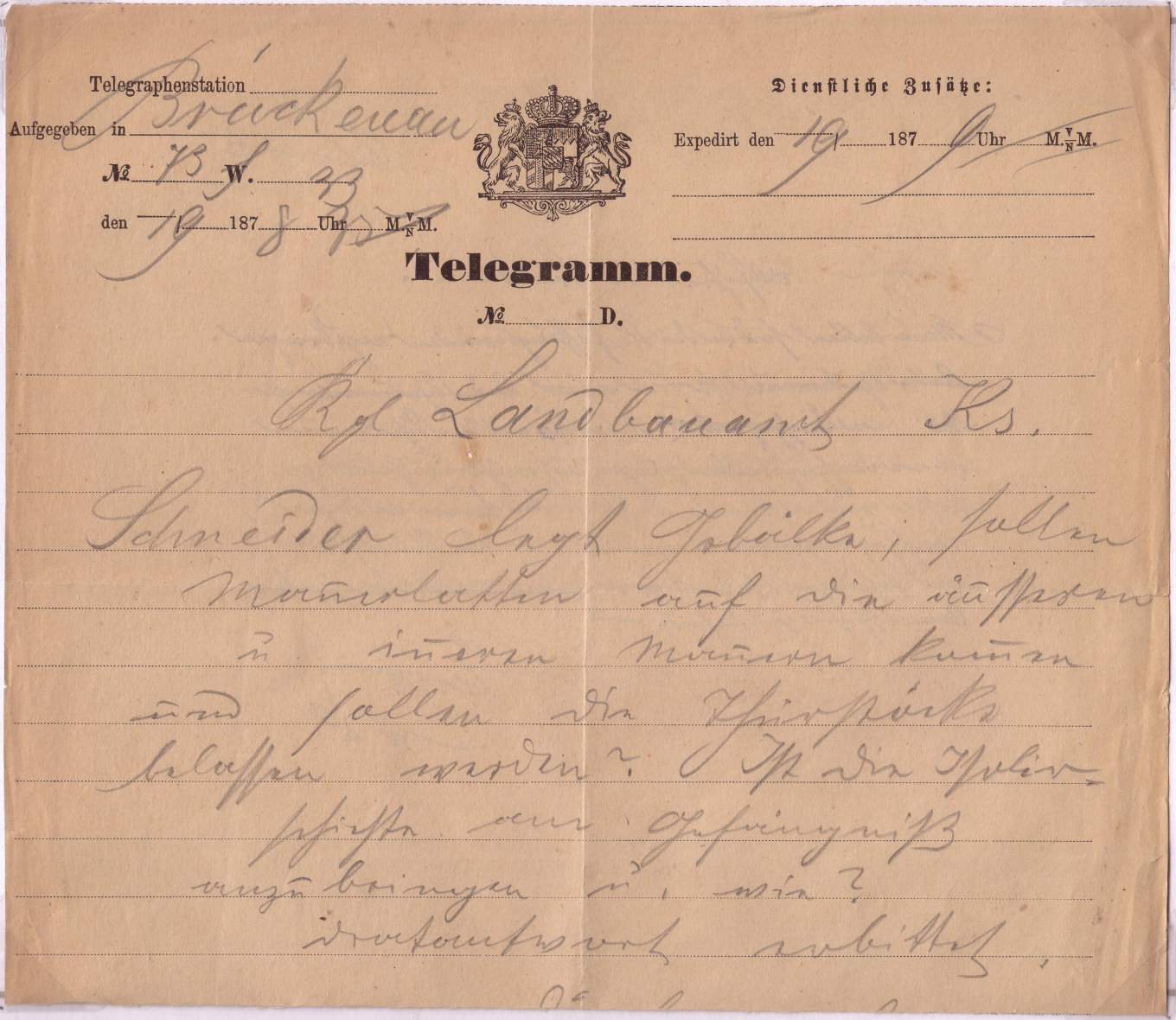
Image courtesy of Rolf Lamprecht.
A Bavarian telegram Form G. D. printed 1892 and used in 1894.
There is an image of the Bavarian Coat of Arms at the top.


Form D 53. A Bavarian telegram used in 1895 (to Prince Luis Ferdinand).
The Bavarian Coat of Arms is at the top. This is just like the German Austria Form G, telegram shown used in 1866

This has the Form Number? D 53. at bottom-left.
Form D 57. A Bavarian telegram printed 1900 and used 23 July 1903 in Nuremburg.
The Bavarian Coat of Arms is at the top.
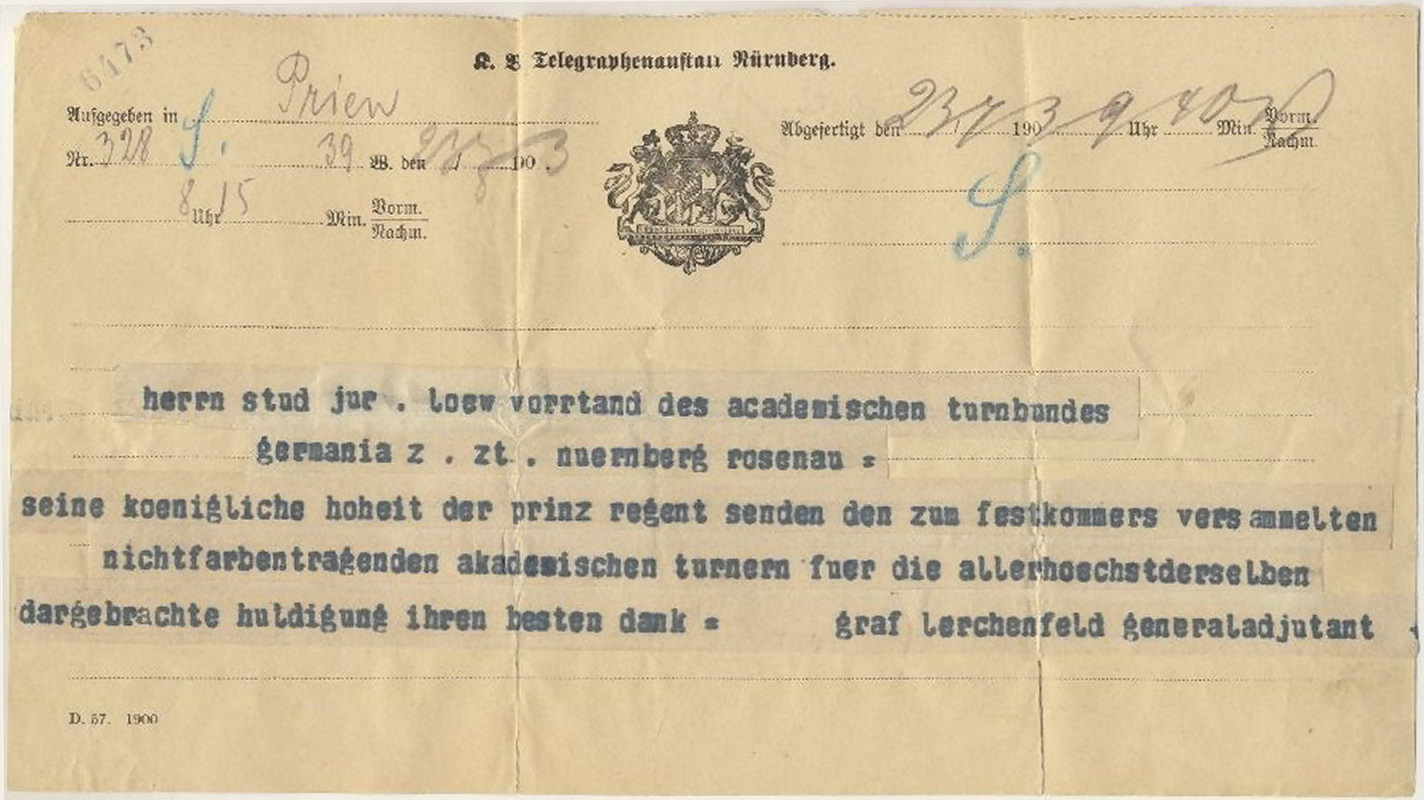
The imprint gives the Form Number D 57., and printing date of 1900.
![]()
The back was lined for the address. The telegram was then folded, and sealed ready for delivery.

Form D 55. A Bavarian telegram printed 1903 and used in 1905.
There is an image of the Bavarian Coat of Arms at the top.
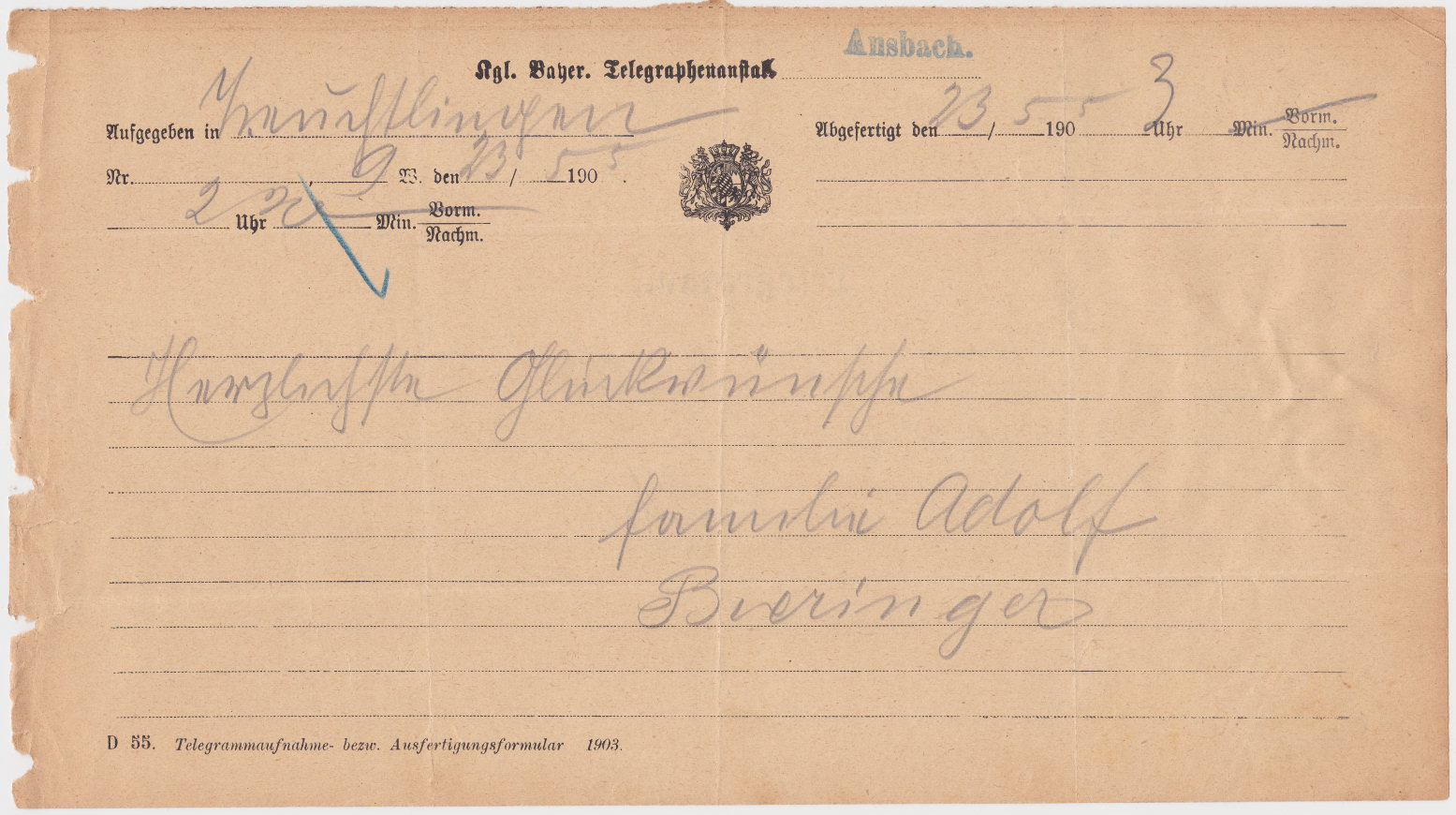
The imprint gives the Form Number D 55., and printing date of 1903.

A space for the address on the back, the telegram is then folded, and sealed ready for delivery.
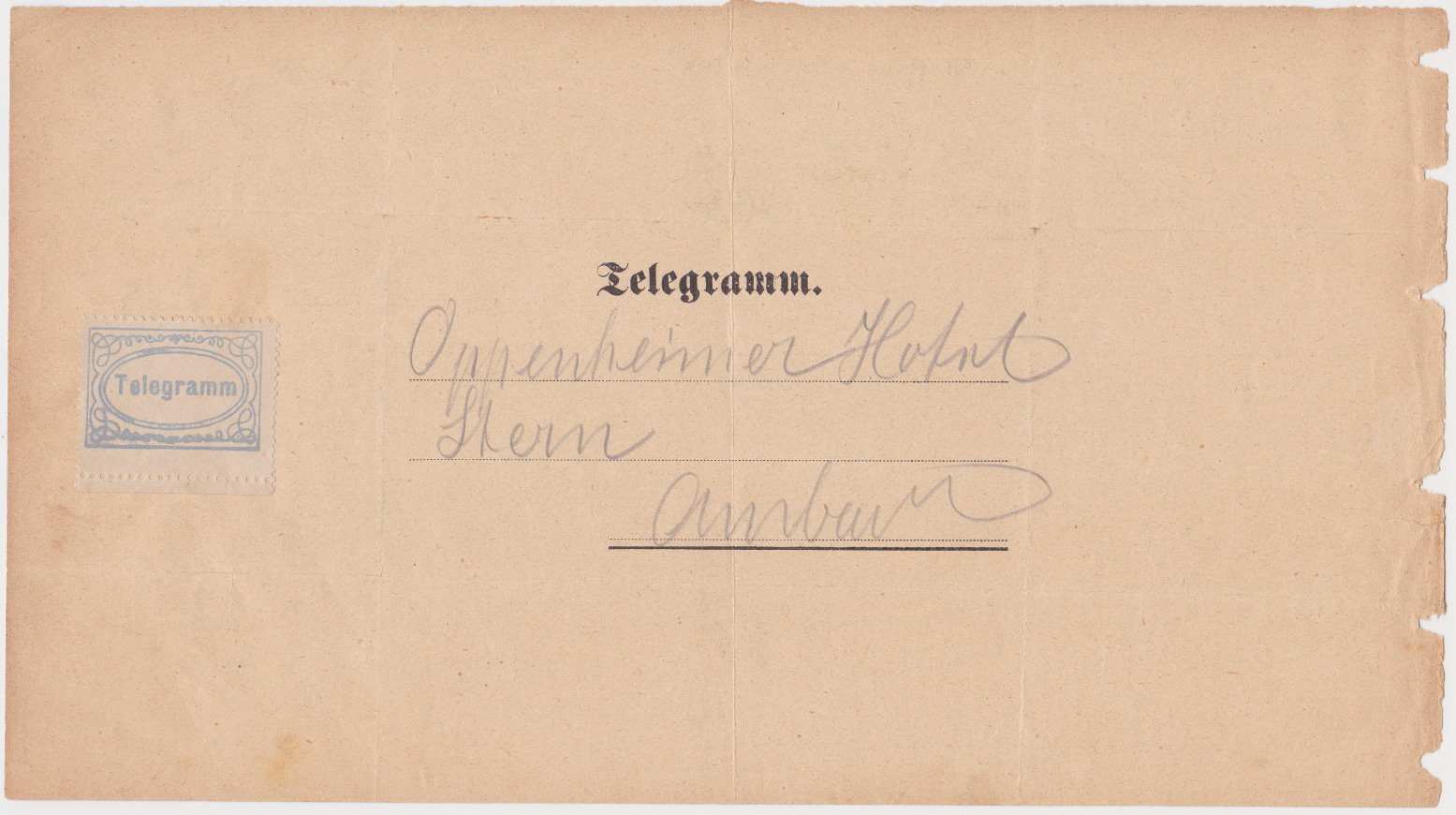
Form D 57. A Bavarian telegram printed 1904 and used in 1904.
There is an image of the Bavarian Coat of Arms at the top.
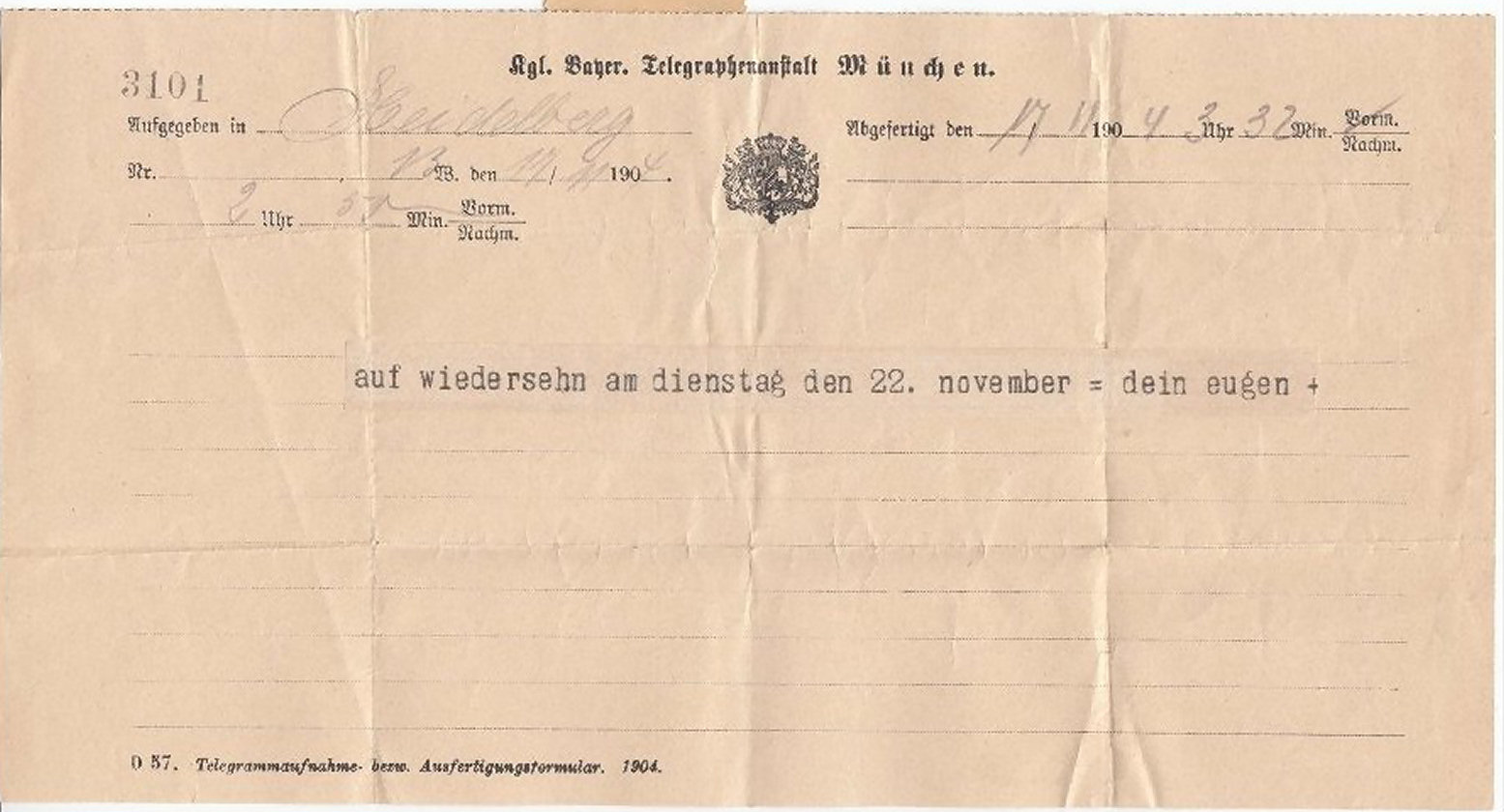
The imprint gives the Form Number D 57., and printing date of 1904.

A space for the address on the back, the telegram is then folded, and sealed ready for delivery.

A new Form D 57. A Bavarian telegram printed 1907 and used in 1908.
There is an image of the Bavarian Coat of Arms at the top.

The imprint gives the printing date of 1907.

A space for the address on the back, the telegram is then folded, and sealed ready for delivery.

Form D 57. A Bavarian telegram printed 1908 and used in 1908.
There is an image of the Bavarian Coat of Arms at the top.

The imprint gives the printing date of 1908.

A space for the address on the back, the telegram is then folded, and sealed ready for delivery.

Back to the old Form D 55. A Bavarian telegram printed 1910 and used in 1910.
There is an image of the Bavarian Coat of Arms at the top.

The imprint gives the printing date of 1910.

A space for the address on the back, the telegram is then folded, and sealed ready for delivery.

A new Form D 57. A Bavarian telegram printed 1914. The date of use seems to have lost importance.
The address is at the top, with the Coat of Arms below. Nothing on the back The telegram is folded and sealed for despatch.
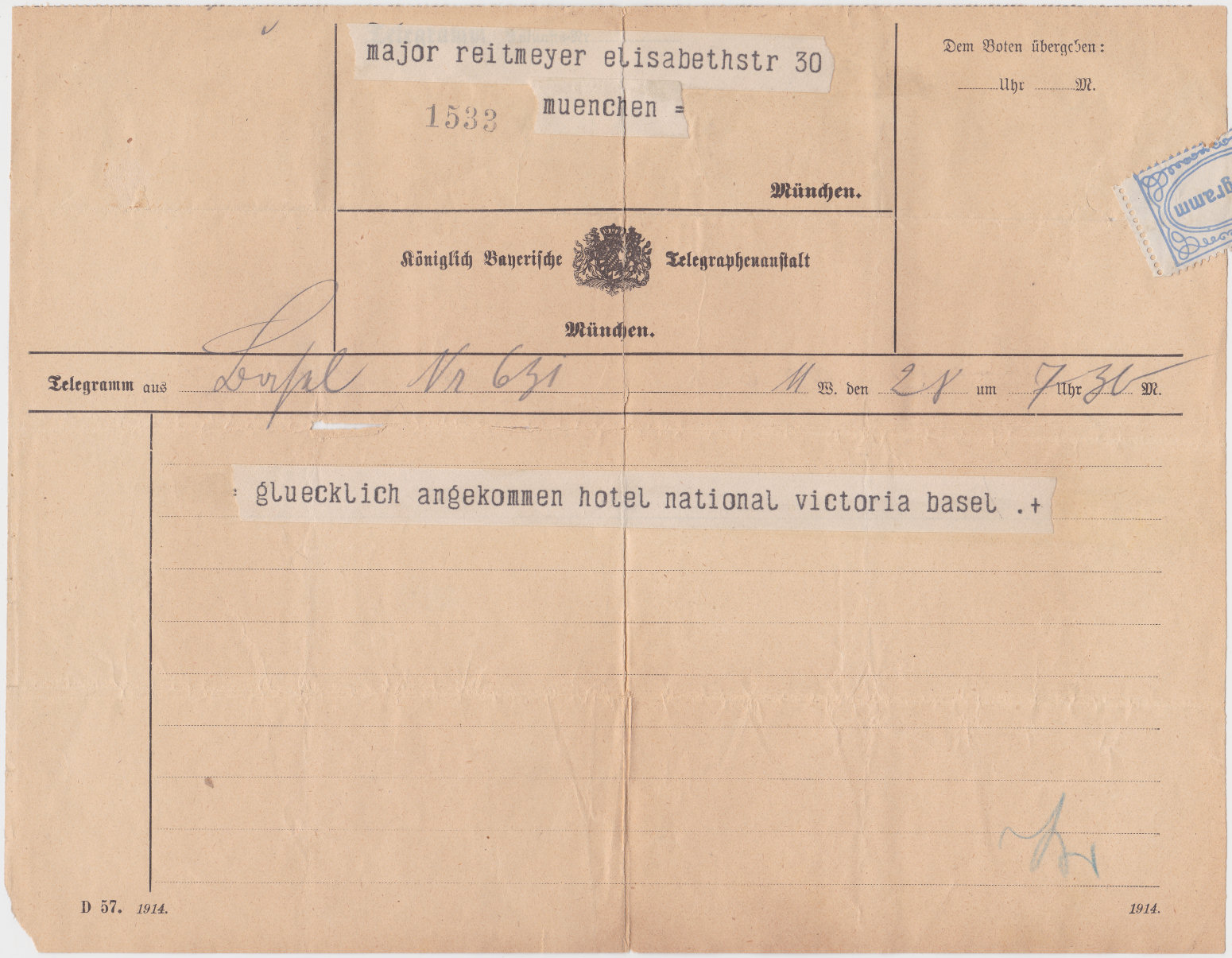
The imprint gives the form number D 57., and printing date of 1914, which is repeated on the right.

Bavarian Envelopes.
A Bavarian telegram envelope used in 1867 before the use of telegram seals.
"P.D." is a common abbreviation for "Paid to Destination".
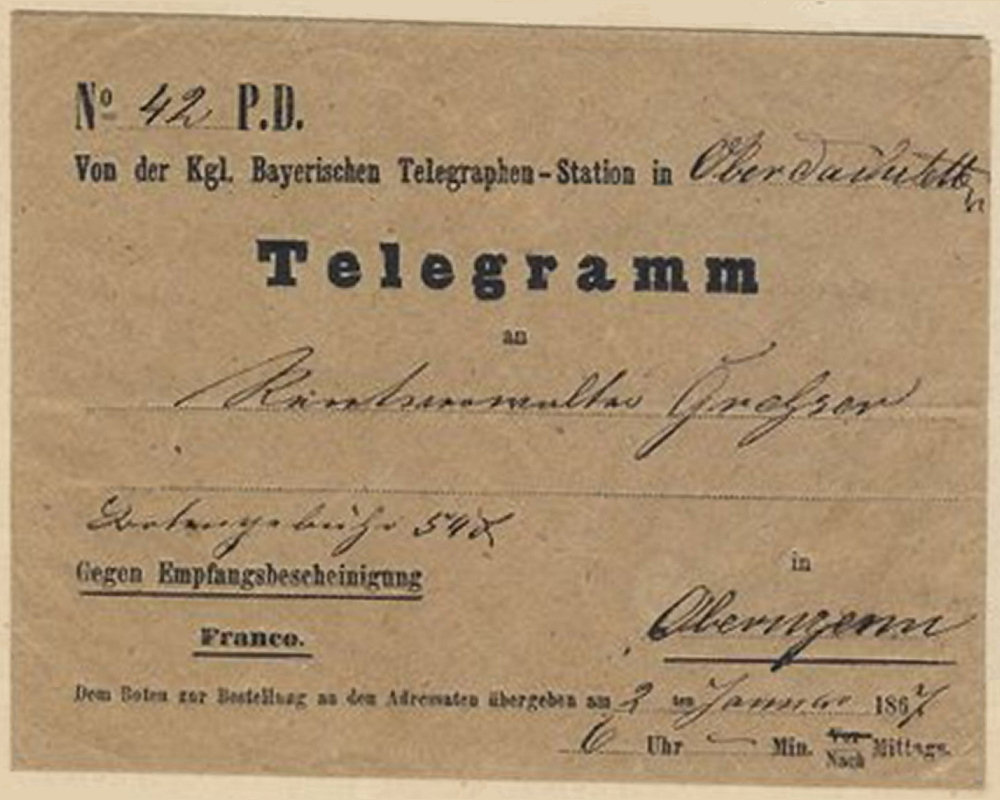
Bavarian telegram envelopes used in 1853 and 1867. The earliest has a telegram seal on the back.

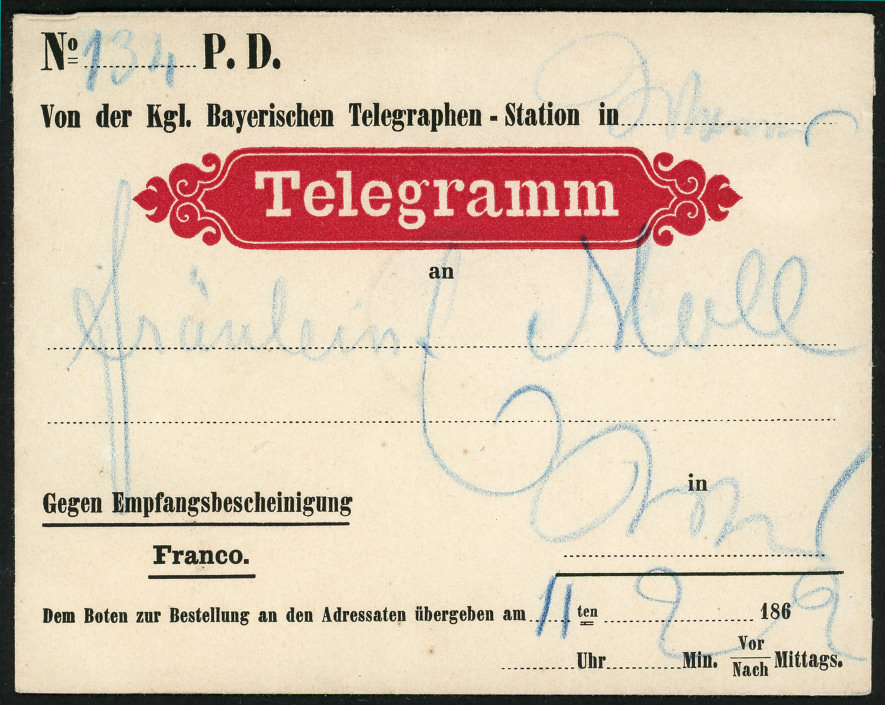
Images courtesy of Auktionshaus Klüttermann GmbH

The 1853 seal used was very faded, so I enhanced it
It has a Coat of Arms and writing around the sides and underneath.
3. North German Confederation.
Following the Austro-Prussian war (1866), a series of treaties, beginning in August 1866, between Prussia and
other North German States led to the creation of the North German Confederation in July 1867 with Berlin as its capital.
Initially Prussian postage stamps were used for telegraphic purposes.
Postage stamps of the North German Confederation became available on 1 January 1868.
I presume that they were then used for telegraphic purposes. Their stamps were superseded by the Stamps of the German Empire
when they became available at the end of October 1872. Apparently the Telegraphic stationery continued to be used for some time.
This form was in the 1869 Berlin envelope shown under Prussia. Dated 3 April 1869.

A telegram of 1869. At the bottom-left is "Lit. B. No. 4a. / Berlin." Image courtesy of Gabriel Coutinho de Gusmão.
This form was in the 1872 Express Berlin envelope shown under Prussia.

A telegram of 1872. At the top-left, it says "Wird eine Berstümelung in der Depesche vermuthet, so wolle man
sich sofort an die Station wenden, welche das Erforderliche veranlassen wird."
which roughly translates as "If the despatch is suspected to have been tampered with, one should immediately turn to the station, which will do the necessary."
At the bottom-left it has "Lit. B. No. 4. Berlin." Image courtesy of Heinrich Koehler Auktionshaus GmbH
4. Danzig Free State.
Form C187. A Danzig telegram printed 1928 and used in 1930.
The address is at the top, with the Coat of Arms below. Nothing on the back The telegram is folded and sealed for despatch.

The imprint gives the printing date of October 1928 with form number C187.
![]()
![]()
Form C187. A Danzig telegram printed October 1932 and used 13 December 1932.
The address is at the top, with the Coat of Arms below. Nothing on the back The telegram is folded and sealed for despatch.

The imprint gives the printing date of October 1932 with form number C187.
![]()
![]()
5. German Empire.
This section starts with the Empire, but since form numbers cut across all periods, I will lump them together and give shortcuts to decades by date of printing (not always clear).
| Shortcuts to other sections | ||||||
| Telegrams from 1890 | from 1900 | from 1910 | from 1920 | from 1930 | from 1940 | Railway |
Form 4a. The earliest appear to have used envelopes for delivery. This is dated in 1873, used at Cologne (Cöln).
The top-left box contains "Lit. B. N 4a." which I take to indicate a form number.

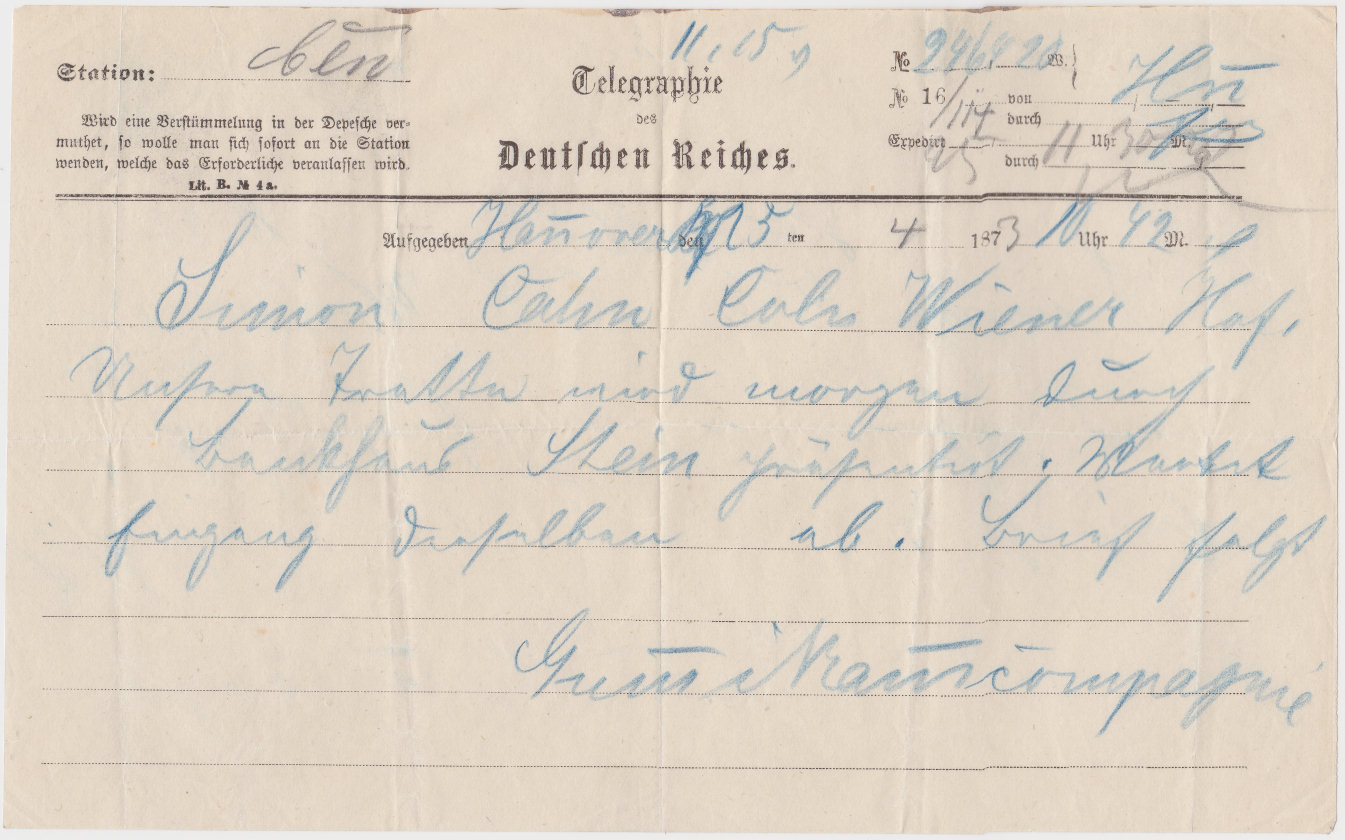
This was in the envelope shown below :


Form C. 187. Form is dated in 1877, used at Cassel.
The address was written on the back, the form folded and then sealed ready for delivery. No envelope needed.

Form number at bottom-right.
Form C. 187. Form, now with a Coat of Arms, is dated in 1880, used at Breslau.
With this the address is written at the top, then as before, folded and sealed.
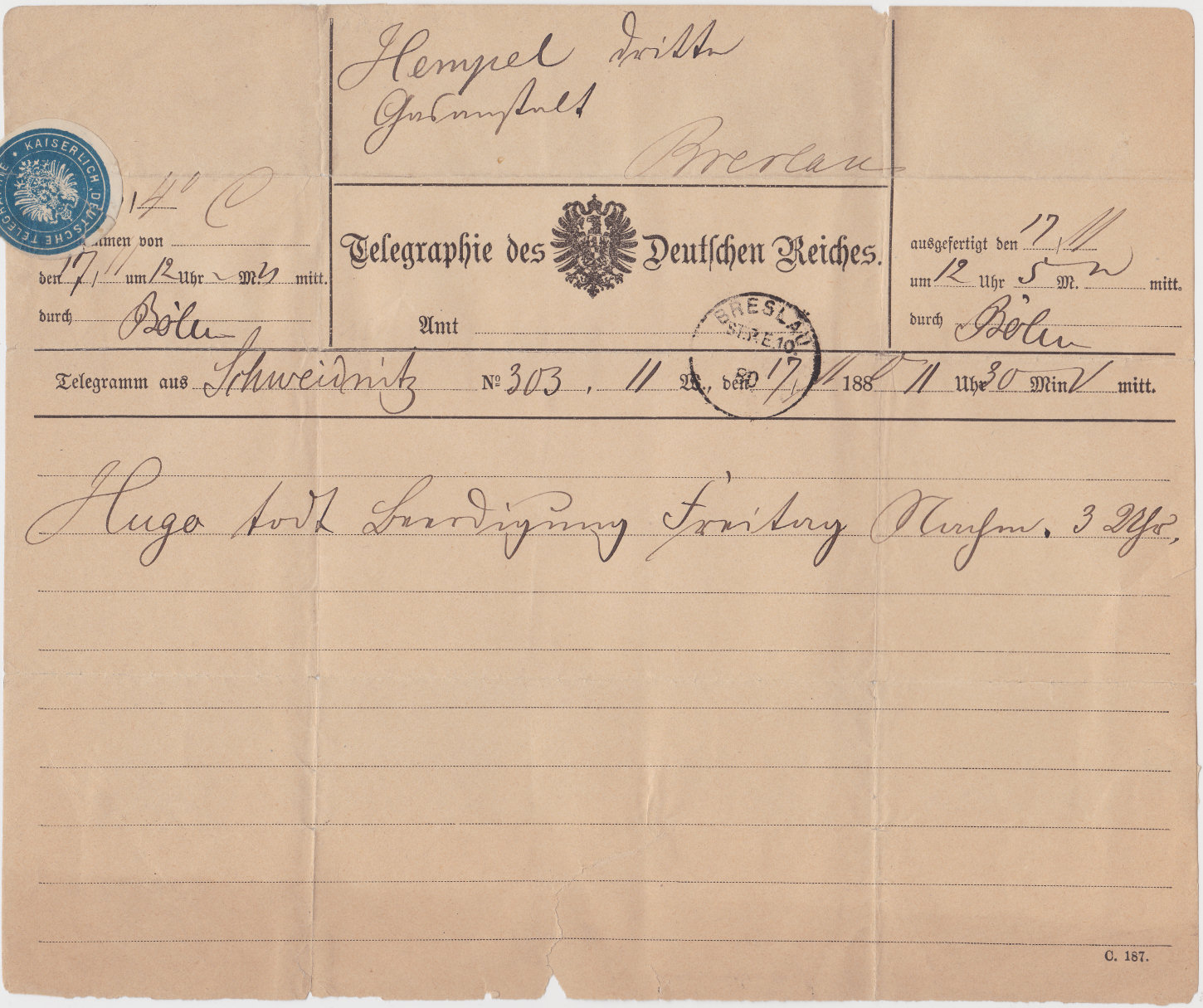
Form number at bottom-right.
Form C. 187. Form, now with a less elaborate Coat of Arms, is dated in 1892.
Year pre-filled with 189_

Form number at bottom-right.
Form C. 187. Form, dated 18/11/1894, used at Frankfurt am Main.
Much the same, except date duplication in top-right box has gone, to be replaced with a time-stamp.
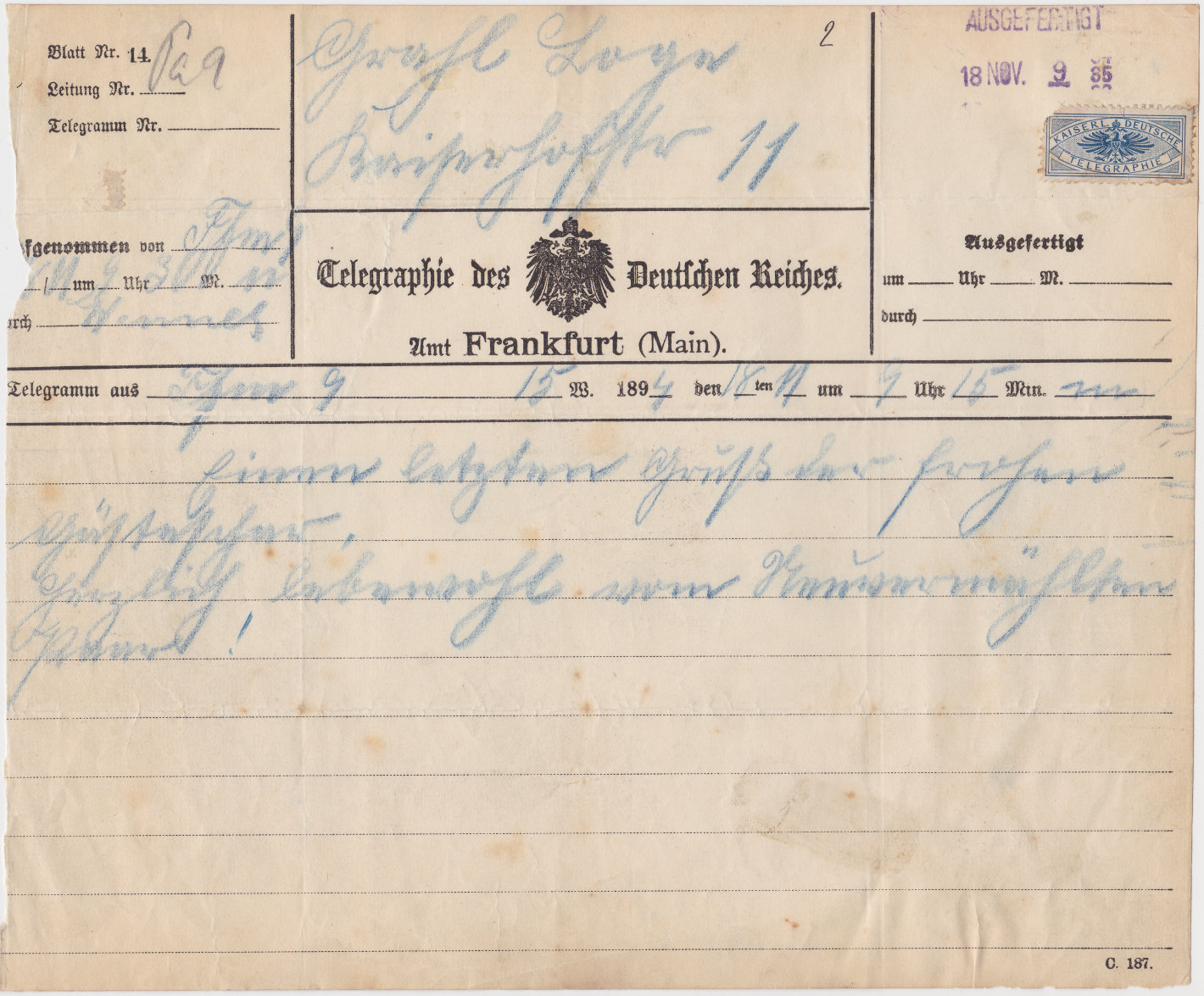
Form number at bottom-right.
Form C. 187. Form, dated 17/12/1909, used in Dillingen,Saar.
"Blatt Nr." at top-left in Fractur. The top-right box is now empty.
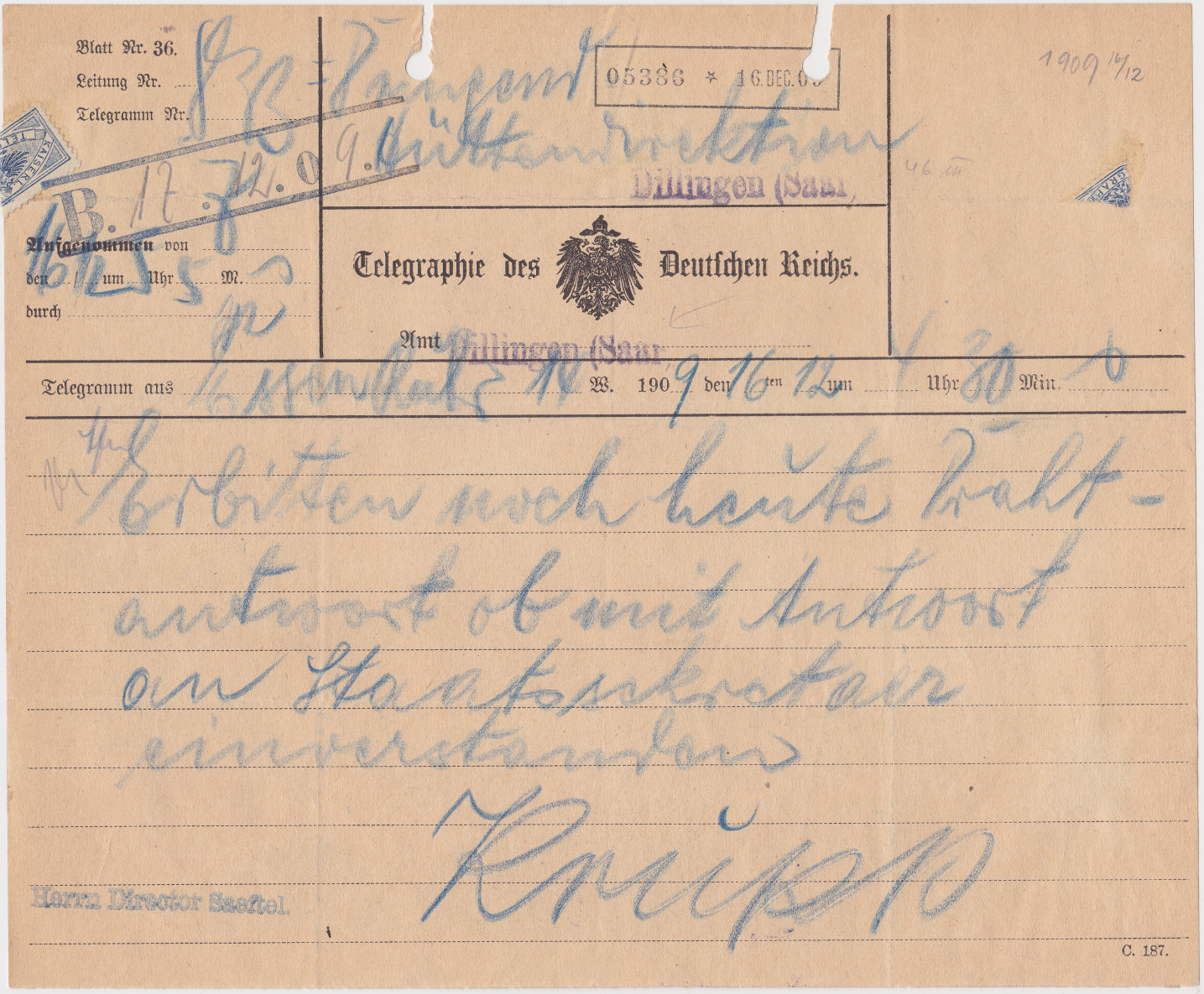
Form number at bottom-right.
Form C. 187. Form, dated 23/7/1908, used at Cöthen (Anhalt).
Large "No." at top-left not in Fractur. The "year" box has moved to the top-left box.

Form number at bottom-right. Image courtesy of Treasurings-Jewelry on eBay.
Form C. 187. Form, dated in 1915, used in Tangerhütte.
Year pre-filled as "191_"
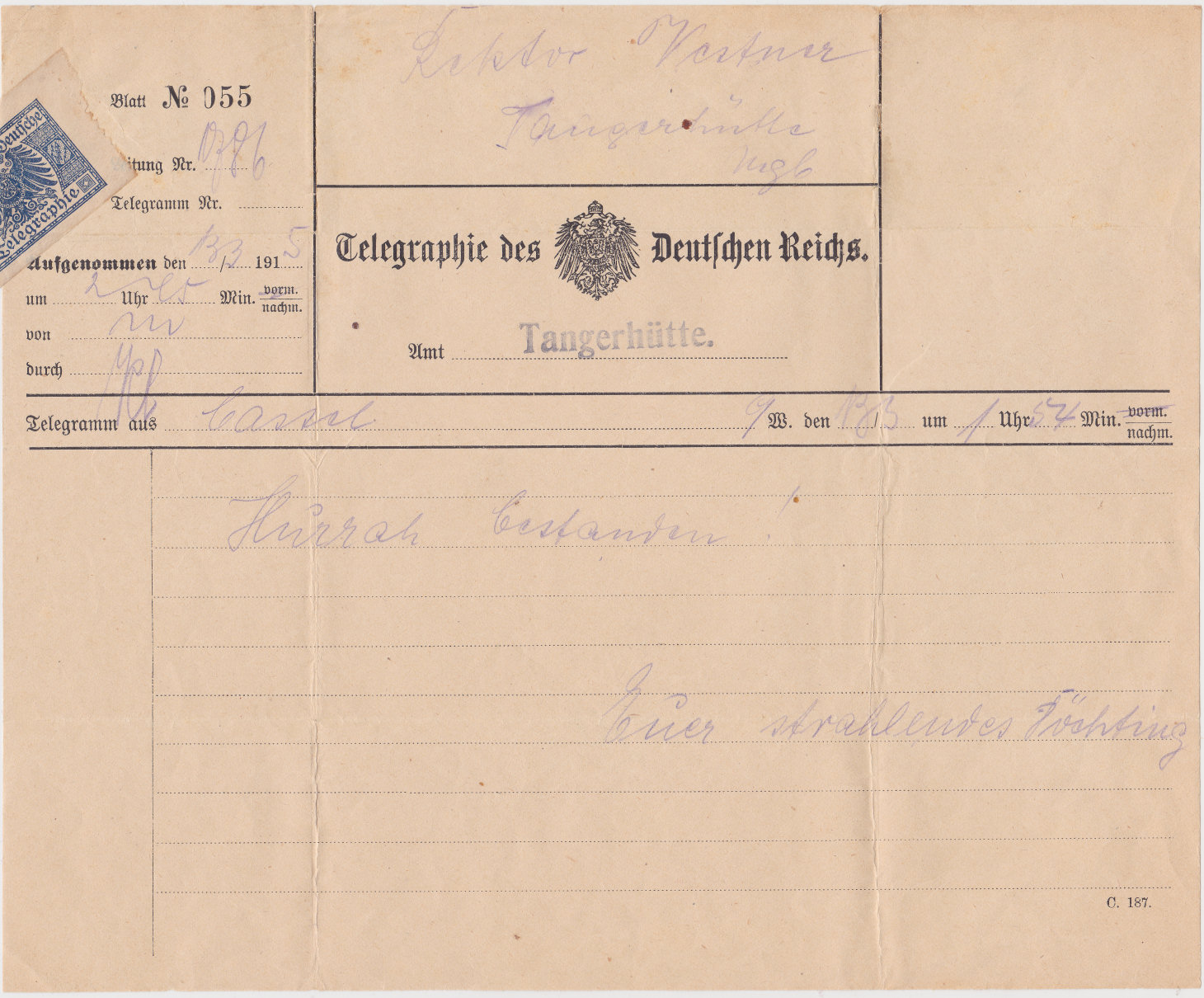
Form number at bottom-right.
Form C. 187. Form, date pre-filled as 191_, but used 2 March 1920, in Greifswald, a port in the northeast.
Similar to the last, except "No." at the top-left is much smaller fractur "Nr".

Form number at bottom-right.
Form C. 187. Form, with pre-printed "192_" and dated 10 September 1921, used in Quakenbrück.
This is almost identical to the last except for a difference of spacing in the "Telegramm aus" area.
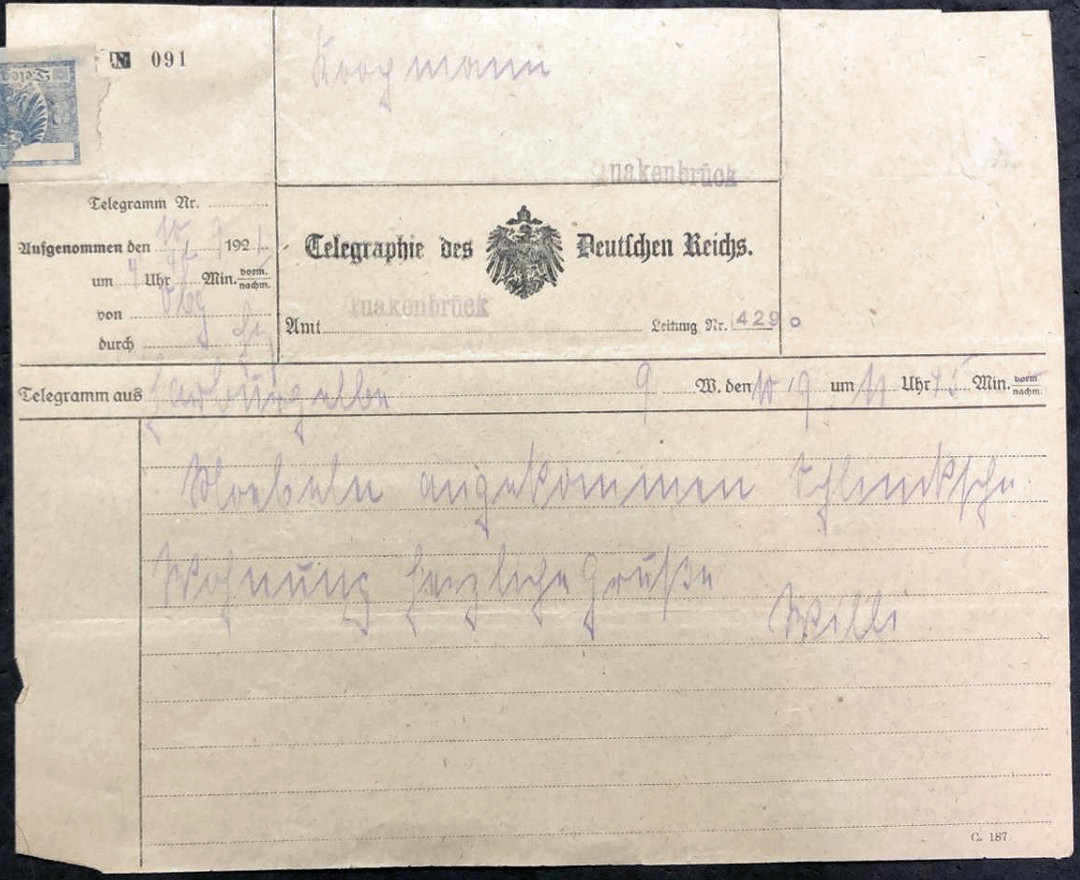
Form number at bottom-right.
The back of this has advertising for the banking house Sanders, Wiecking & Co., of Osnabrück.

Images courtesy of Beto Assef Filatelia (click image for listing).
Form C. 187. Form, with pre-printed "192_" and dated 9 February 1924, used in Berlin Head Telegraph Office.
There is information back in the top-right box. The Coat of Arms has been overprinted, for the same reason the top of the seal was torn off (no more Kaiser).
Modified slightly for use in Berlin.
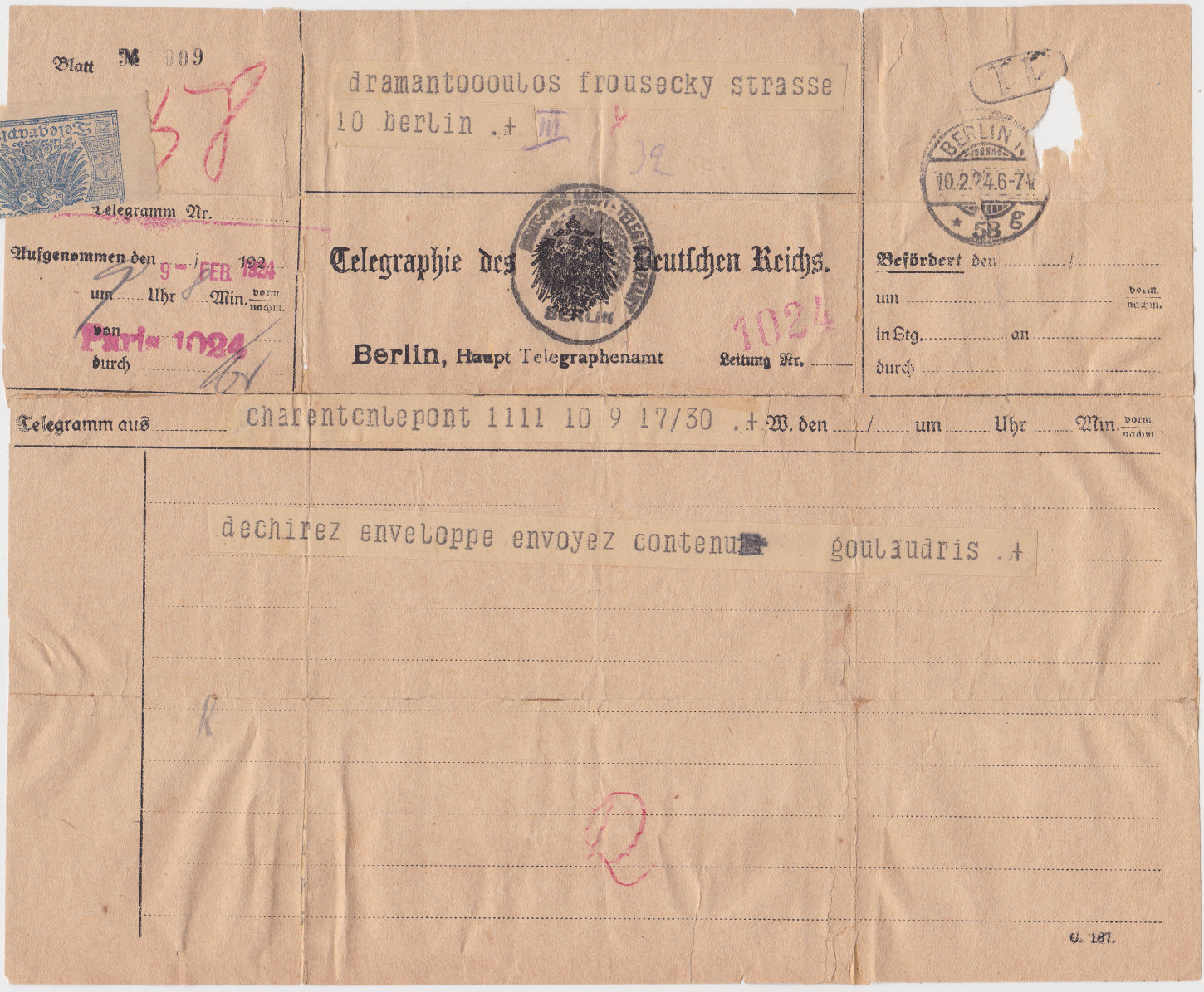
Form number at bottom-right.
Form C. 187. Form, dated 12 September 1924, used in Lippstadt.
The Coat of Arms has been changed, no more Crown. The seal has likewise beed changed.

The Form number lives on.
Form C. 187. Form, again 1924, this is an interestig item to the Argentine Consulate in Hamburg.
Seeking permission for 11 and 12 year old children to disembark. Photos added to the back by the consulate and stamped.
Note the perforated date at bottom-right and red marker at the top (a poition for those appears on later forms).

It would seem that the end result of this is to create a visa for the children.

The Form number lives on.
Form C. 187. Form, Another red strip, this to Berlin with political issue. Again a perforated date.
Still with Arms, dated 28 October 1924.

The Form number is still unchanged.
Form C. 187. Form, Still with Arms, dated 24 May 1925.
I include this largely because of the Seal. Would you have guessed it was German?
This is the only one I have seen and it was used at the Telegraph Station at Krappitz, now known as Krapkowice in Poland.

The Form number is still unchanged.
Form C. 187. Form, Shortly after this, the Coat of Arms disappeared from the form, though without immediately changing the form number.
"Telegraphie des Deutschen Reichs" has also changed to "Deutscher Reichstelegraph".
Here is an example. Like so many, the date information is lacking.

The Form number is still unchanged.
![]()
Form C. 187. Form, dated December 1925, now the Coat of Arms has disappeared from the form, though without immediately changing the form number.
Another to the Argentinian Consul, no red tape, but still the perforated date.

The Form number is still unchanged.

Form C. 187. Form, dated 12 August 1926, without the Coat of Arms, but this has a change to the form imprint.
It now has a printing date of March 1925, and advertising on the back.

The Form imprint has changed with a March 1925 printing date.

This introduced advertising to the back of the forms.

Form C. 187. Form, dated 1 August 1928, without the Coat of Arms, but this has a change to the form imprint.
It now has an Eagle Logo and a printing date of December 1925
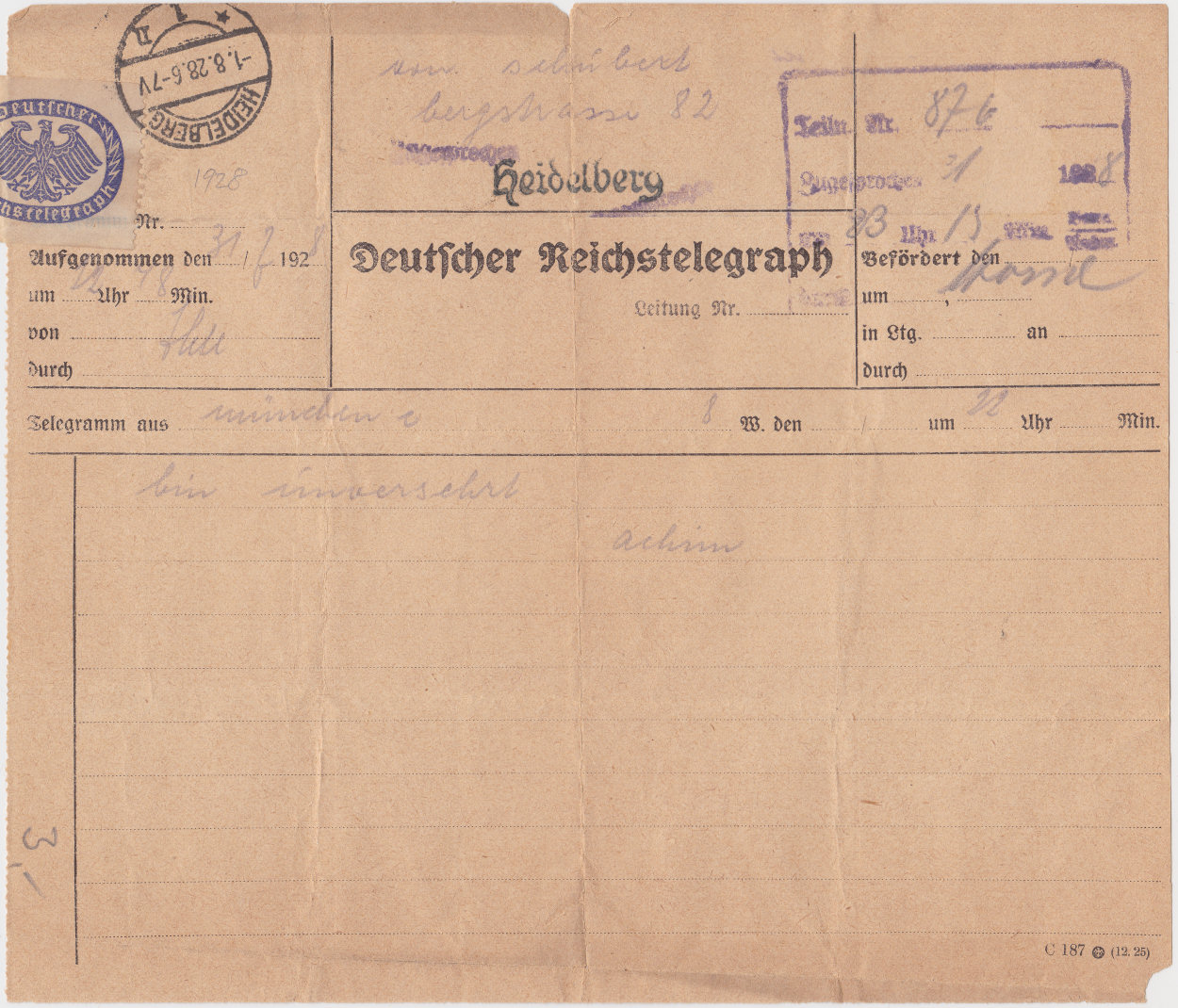
The Form imprint has changed. Print date of December 1925.

Form C. 187. Form, dated 18 September 1928, used in Berlin, with a change to the form imprint.
It also has an Eagle Logo on the imprint, dated December 1927. Numbered perfin at top-right.

Could "HTA" stand for "Haupt Telegraphen Amt"? The Form imprint suggests a printing date of December 1927.

Form C. 187. Form, dated 28 June 1929, used in Munich, with a change to the form imprint.
The imprint is very simple, dated May 1928.

The Form imprint suggests a printing date of May 1928.
![]()
![]()
There is a backstamp giving 28 June 1929 as the date of use.

Here I have an approximately 13 year gap in my collection (no new seals). Can anyone help fill it ?
Form C. 187 Form, dated 2 March 1943, now headed "Deutsche Reichspost" (in fraktur), and a change to the form imprint.
Note that there is now a marked area at the top for coloured tapes. This has a printing date of April 1941.

At bottom-left is now a box marked "Raum Für dienstliche Rückfragen" = "Room For official Inquiries".
The Form imprint has changed. Print date of December 1942.


I suspect that the "A5" refers to half "A4" size paper. "Din" no idea.
Form C. 187 Form, dated 19 January 1945, with a change to the form imprint.
This has a printing date of June 1942.

The Form imprint has changed. Print date of December 1942.


Form C. 187a Form, undated, but headed "Deutsche Reichspost"(in fraktur), and no form imprint date.
It looks like it should fit about here. Used in Kirchberg an der Wild (now in Austria).
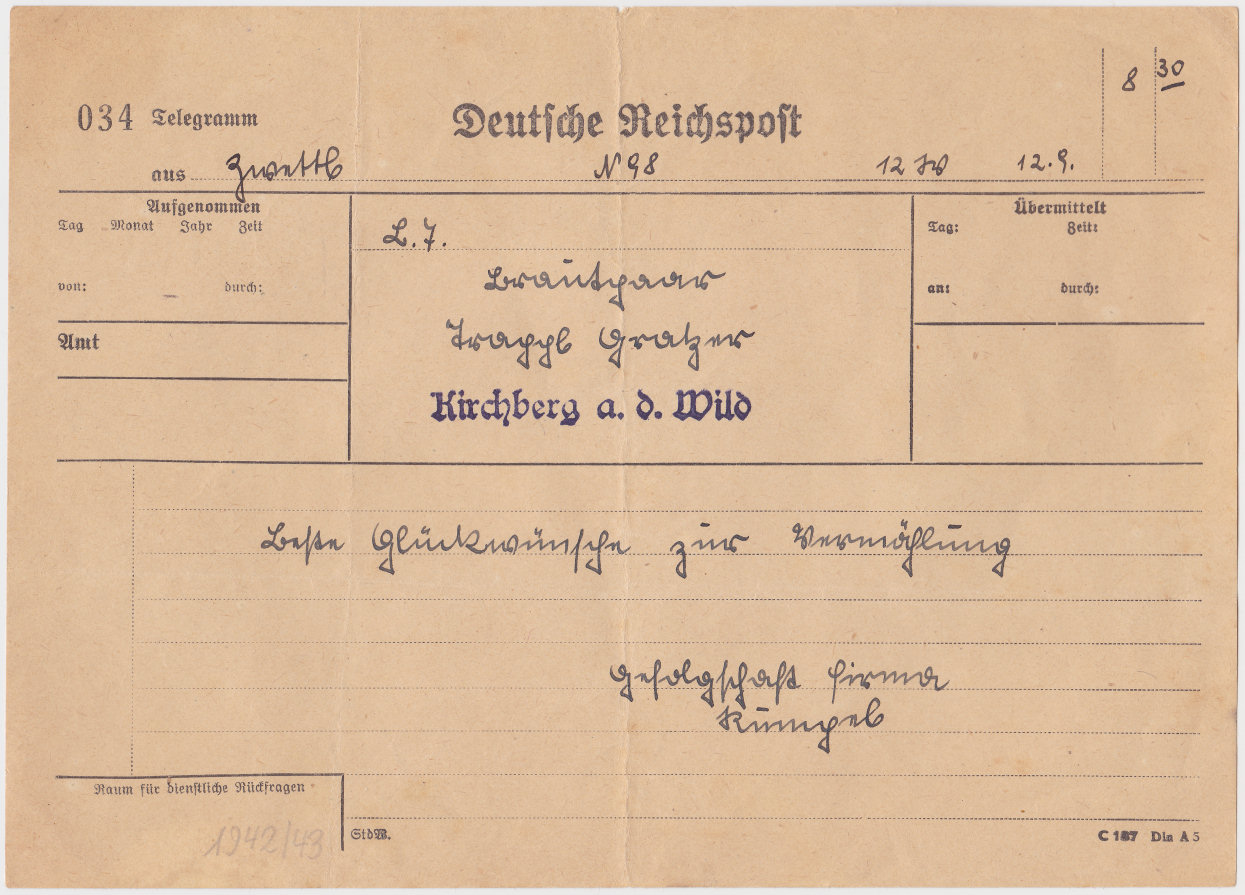
New Printhouse. The Form imprint has changed. No print date.


Form C. 187a Form, dated 19 January 1945, now headed "Deutsche Reichspost"(not in fraktur), and a change to the form imprint.
It now has an Eagle Logo and a printing date of December 1942.

The Form imprint has changed. Print date of December 1942.


Form C. 187 Form, used at Mannheim in (I think) 1950, but printed (I think) May 1943.
This has a printing date of May 1943.

The printed date is a different spacing to the form, the month is quite literally on "Monat" and the year, before "Jahr", looks like 50.
In the place where a seal would be expected is something that I do not recognise. It looks like a postage stamp?!

The left imprint has a new Logo followed by "5. 43 200 100"(I think). The right imprint has "X C 187 Din A 5 (K1. 29) ".


Form C. 187 Form, dated 21 January 1944, a change to the form imprint.
This has a printing date of June 1943.

The Form imprint has changed. Print date of June 1943.


Form C. 187 Form, dated 23 March 1944?, a change to the form imprint.
This has a printing date of July 1943.

The Form imprint has changed. Print date of July 1943.


Form C. 187 Form, dated 8 November 1944, a change to the form imprints.
This has a printing date of May 1944.

The Form imprint has changed. Print date of May 1944.
![]()
![]()
Form C. 187 Form, dated 11 February 1944, a change to "Deutsche Post" and the form imprints, no printing date.
Used at Budenheim in the French Zone. Note the top-left numbering, it changes (that's an over-inked asterisk).


The Form imprint has changed. "Waldkirch".


Form C. 187 Form, undated, but imprint suggests July 1947 as printing date. A change to the form imprints.
Used in the French Zone again. Note the top-left numbering, the asterisk has rotated 30°.

The Form imprint has changed. "747. Waldkirch" could imply a printing date of July 1947.


Form C. 187 Form, dated 24 April 1949, a change to the form imprints, no printing date.

I have made a point of magnifying and enhancing this date area of the form. The spacing of the printing does not match that of the form.
This is dated 24 / IV / 49 with the "15 37" being a time. The lack of ink can cause mistakes.
The top-left numbering has changed completely, though the imprint is still "Waldkirch" though back to the 1944-style imprints.


The Form 1944-style imprints. "Waldkirch".


Having exhausted my Waldkirch imprints, I'll get back to chronological order. (with Deutsche Reichspost)
Form C. 187 Form, dated by seal as August 1944. Used at Eichstätt, Bavaria. The form imprints have no printing date.

The Form imprint has changed. No print date."StdW" probably indicates who printed it.


Form C. 187 Form, used in 1947. Used at Luszyn (now in Poland). The form imprints suggest a printing date of February 1946.
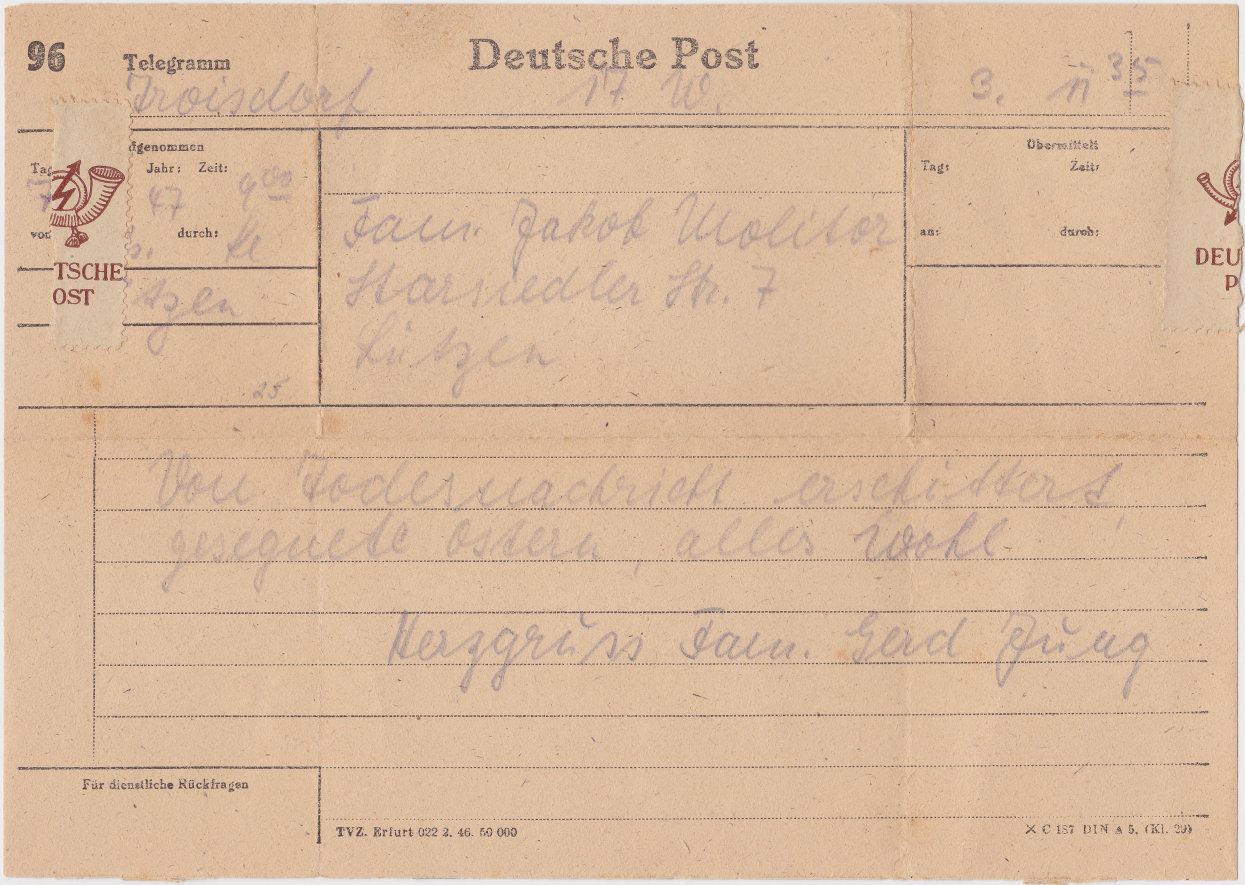
The Form imprint suggests a printing date of February 1946 in Erfurt, Thuringia.
![]()
![]()
It would seem that the switch from Deutsche Reichspost to Deutsche Post on forms and seals occurred in 1946, but with no definite date.
Perhaps old forms continued to be used until they ran out, or old printing contracts continued until they were fulfilled.
Form C. 187 Form, used 9 January 1948. Used at Stafanstalt Celle. The form imprints suggest a printing date of July 1946.
This has Deutsche Reichspost under the strip at the top, and on the seal.

The Form imprint has "Hess, Braunschweig. 7. 46. 200 000. " Braunschweig was the printing house in Lower Saxony. Printing date probably July 1946.
![]()
![]()
Form C. 187 Form, late used? (7 October 1948 someone has written). The imprint has Karlsruhe but no printing date. I think it goes about here.
This has Deutsche Reichspost at the top, though with a Deutsche Post seal. It is the only one I have seen with "Telegramm" on the right.
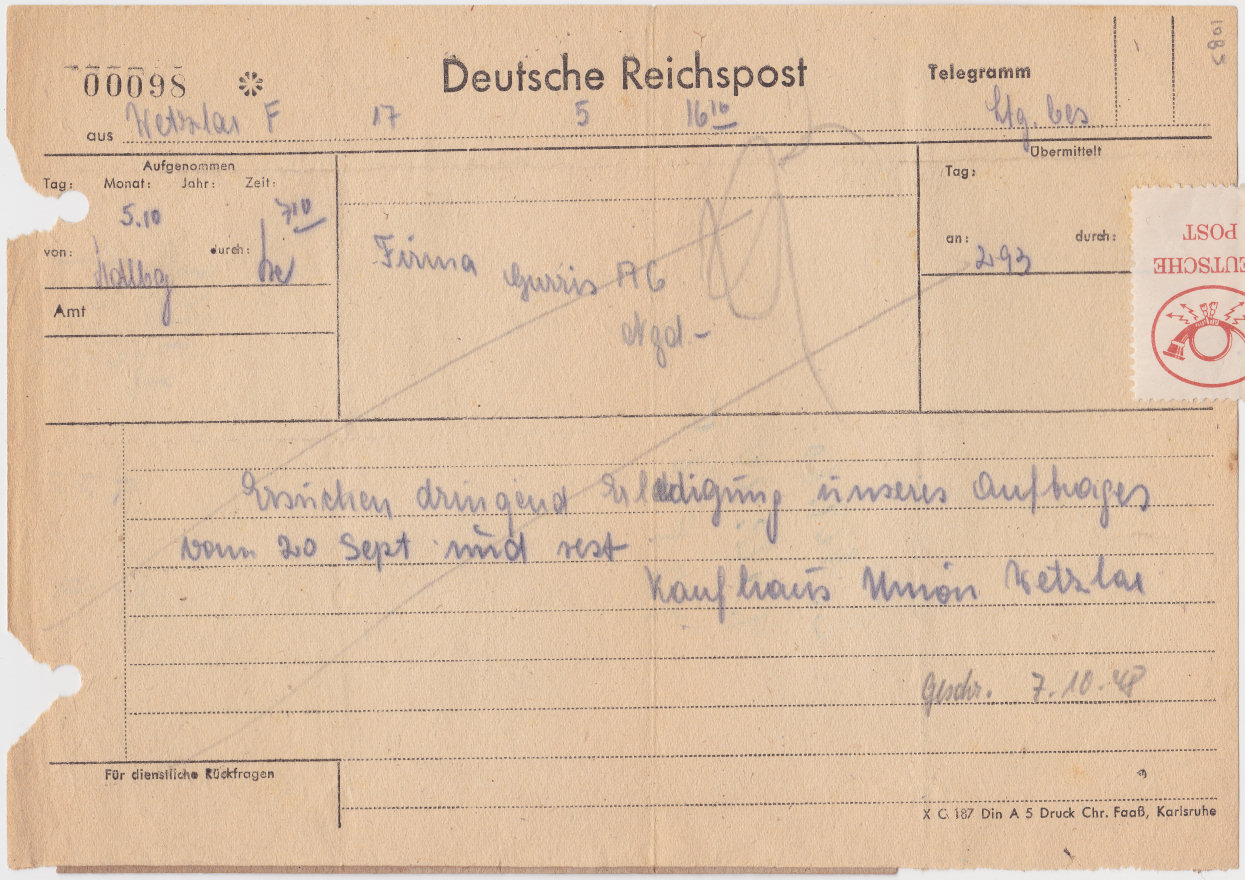
The Form imprint has "Karlsruhe" but there is no printing date.
![]()
Form C. 187 Form, used June 1947. The form imprints suggest a printing date of March 1947.
This has Deutsche Post at the top, and on the seal.

The Form imprint suggests a printing date of March 1947.
![]()
![]()
Form C. 187 Form, undated. The form imprints suggest a printing date of April 1947.

The Form imprint suggests a printing date of April 1947.
![]()
![]()
Form C. 187 Form, undated and without printing date either, but seems to go with the two above.
"Deutsche Post" under the strip. It is also the only example I have seen with this seal.

The Form imprint suggests it was printed in Saxony, but printing date not given.
![]()
![]()
Form C. 187 Form, used 14 June 1948. The form imprints suggest a printing date of November 1947.

A logo to identify the printer. The Form imprint suggests a printing date of November 1947.


Form C. 187 Form, used 14 September 1949 in Budenheim. The form imprints suggest a printing date of January 1948.

A logo to identify the printer. The Form imprint suggests a printing date of January 1948.
![]()
![]()
Form C. 187 Form, used 2 August 1950 in Königslutter, Braunschweig. The form imprints suggest a printing date of April 1948.

Printed in Hannover. The Form imprint suggests a printing date of April 1948.
![]()
![]()
Form C. 187 Form, used 16 September 1950 but without dated form imprint.
The style suggests it fits about here.

Form imprint undated.
![]()
Form C. 187 Form, used 25 March 1950 in Offenbach. The form imprints suggest a printing date of June 1949.
This is the only one I have seen with blue tape.

Printed by C. W. Schirm. The Form imprint suggests a printing date of June 1949.
![]()
![]()
Form C. 187 "Deutsche Bundespost" Form, used 8 December 1954. The form imprints suggest a printing date of July 1954.
Still a space for coloured tape.
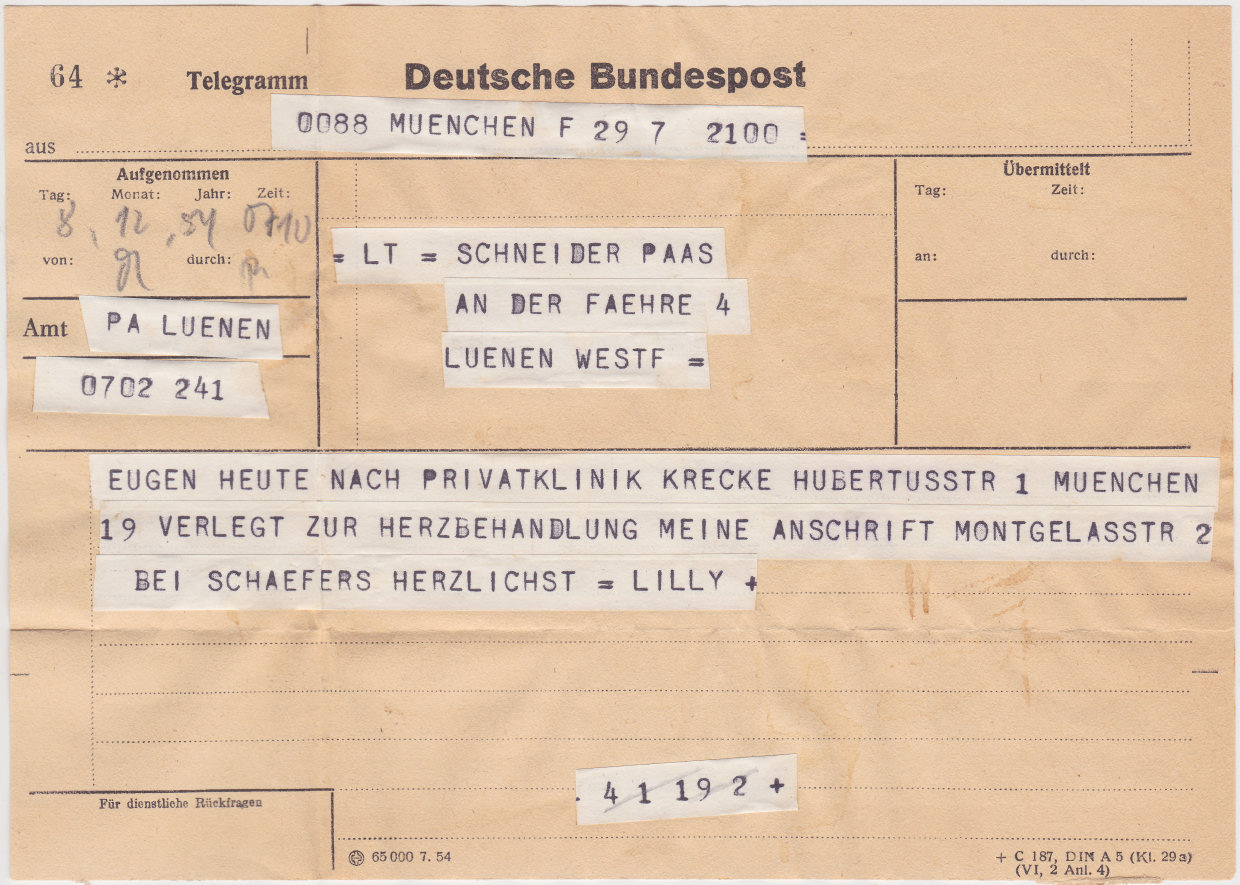
New Logo. The Form imprint suggests a printing date of July 1954. Now "(Kl. 29a)", whatever that means ?


Here I have another gap (approximately 10 years) in my collection (no seals). Can anyone help fill it ?
Form C. 187 "Deutsche Bundespost" Form, used 24 October 1967 in Altötting. The form imprints suggest a printing date of February 1964.

Printed by Schick. The Form imprint suggests a printing date of February 1964. Now "(Kl. 30a)".


Railways
Form C. 183a "Kaiserlich Deutsche Eisenbahn-Telegraph" (in Fractur) Form, used 29 April 1908 in Borm.
The left side panel lists many abbreviations that may be used.
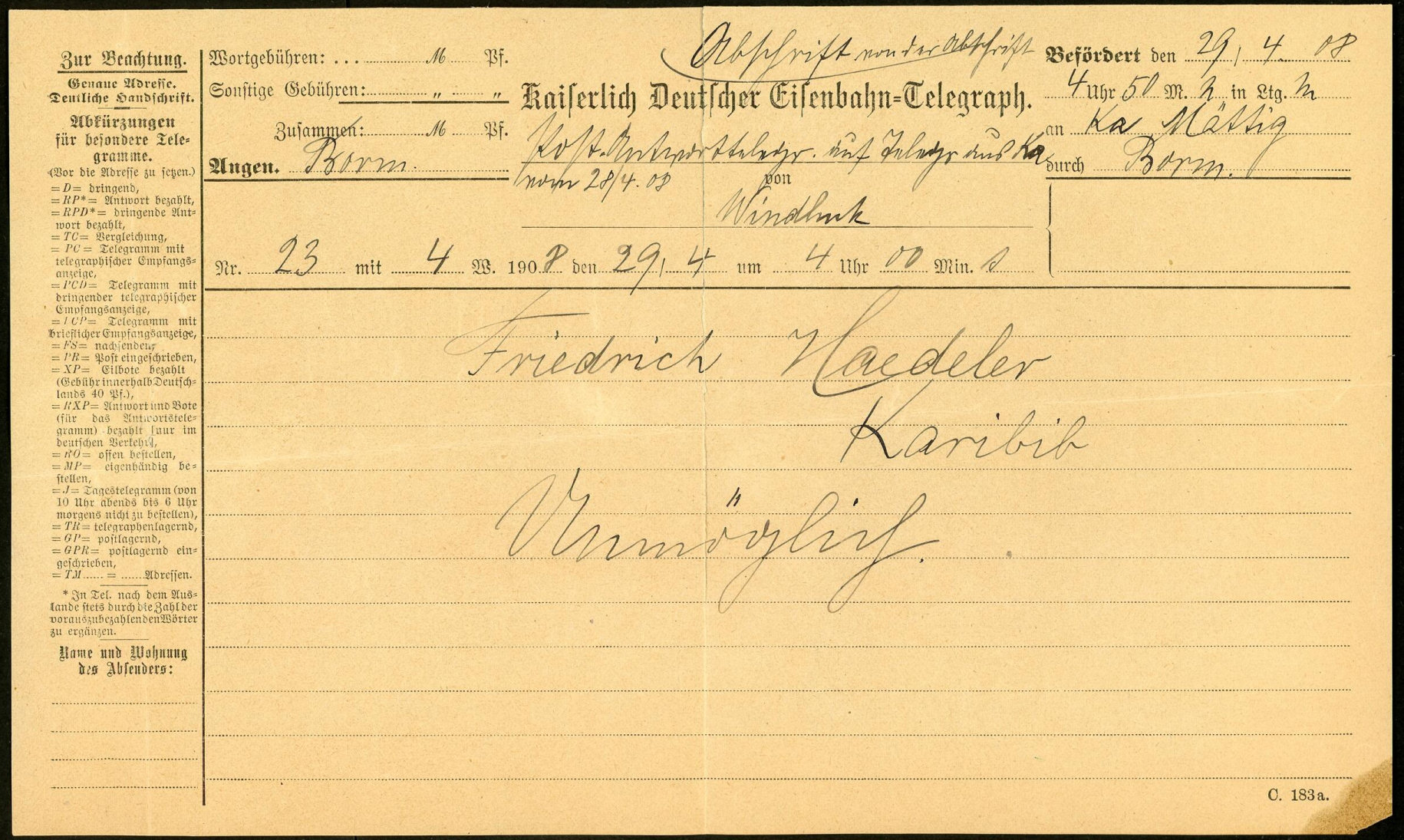
Image courtesy of Auktionshaus Klüttermann GmbH
5a. Telegraph Dept.
A delivery envelope unconventionally used 19 January 1906 in Warmbad, German Southwest Africa, now Namibia.
At the top is printed "Telegraphenabteilung" meaning "Telegraph department."
The script along the bottom is not easy to render in Modern German, but roughly "Umschlag ist dem Überbringer zurückzugeben." or "The envelope must be returned to the carrier.."
Image courtesy of Gabriel Coutinho de Gusmão.
6. D.R.G.M.
I don't think these are Telegraphic at all since they use spoof cancels and seals.
They are just greetings/congratulatory cards intended to look as if they are.
But for the sake of interest ....
The spoof Coat of Arms is surrounded by "Glückwunsch Telegramm" meaning "Congratulations Telegram".
The "Cancel" contains Gesundheit (Health) / Glück (Luck) / Frohsinn (Gladness). This has been filled in for Merseburg 30 ? 1917. Merseburg is a city in Saxony-Anhalt.

An imprint of D.R.G.M. - see they don't go un-noticed.

Another similar "Congratulations Telegram".
No attempt to fill this in.

The same imprint of D.R.G.M.

7. Envelopes.
Like the telegrams , I will lump them together and give shortcuts to decades by date of printing (not always clear).
| Shortcuts to other sections | |||
| Envelopes from 1940 | from 1950 | from 1960 | from 1970 |
This envelope repeated from above. It is dated in 1873, used at Cologne (Cöln).
shortly after this, seals were used so envelopes were not needed.


Envelope Type 187.
This envelope has a printing date of November 1941. "Inliegend Telegramm" = "Enclosed Telegram".

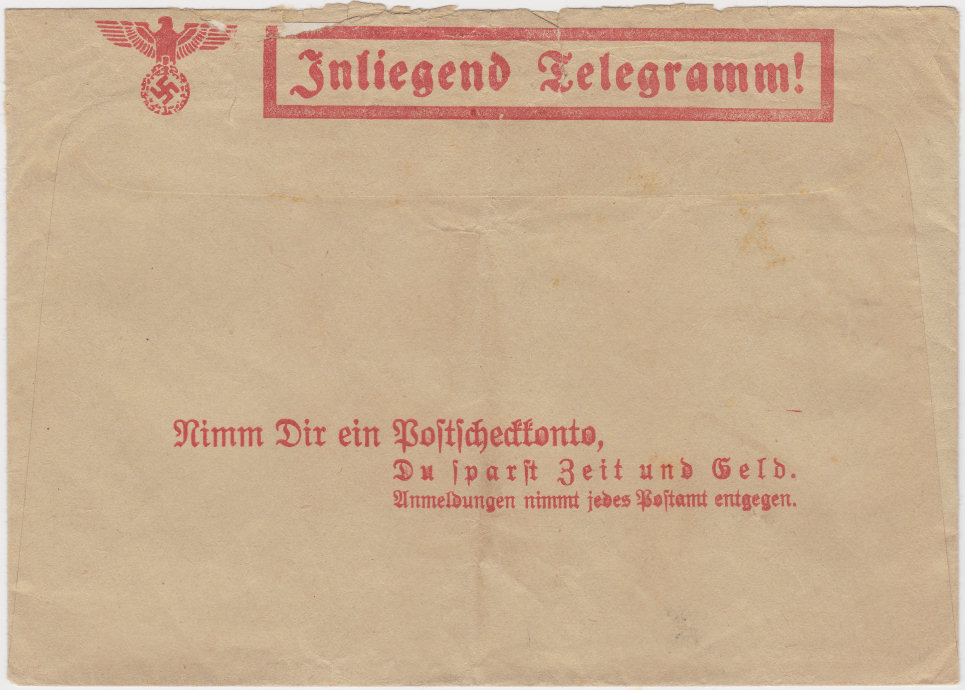
"H. K." November 1941


This envelope has a printing date of November 1942.
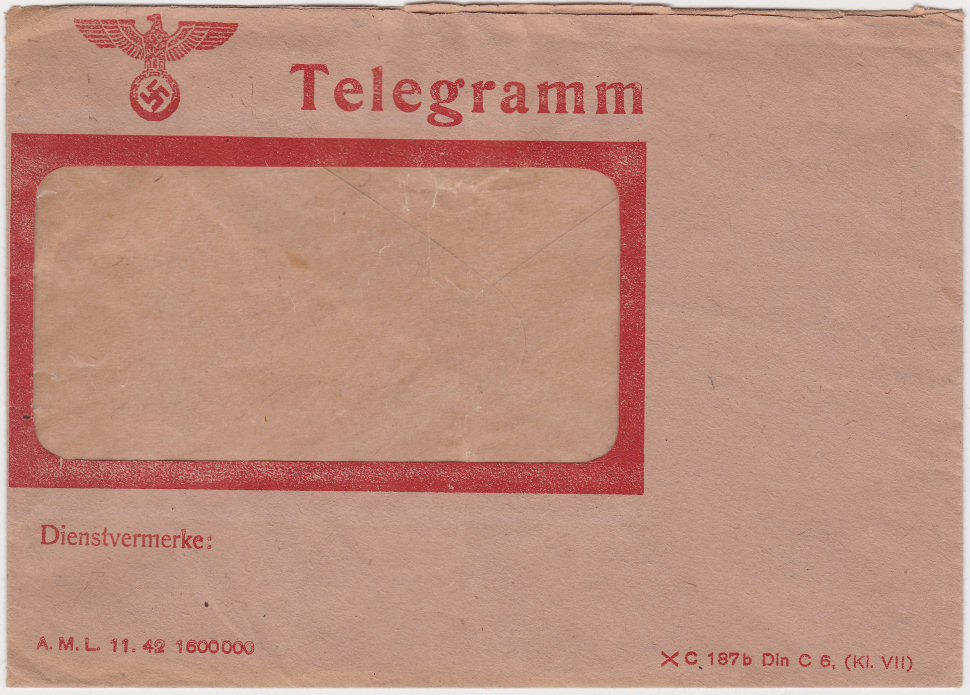
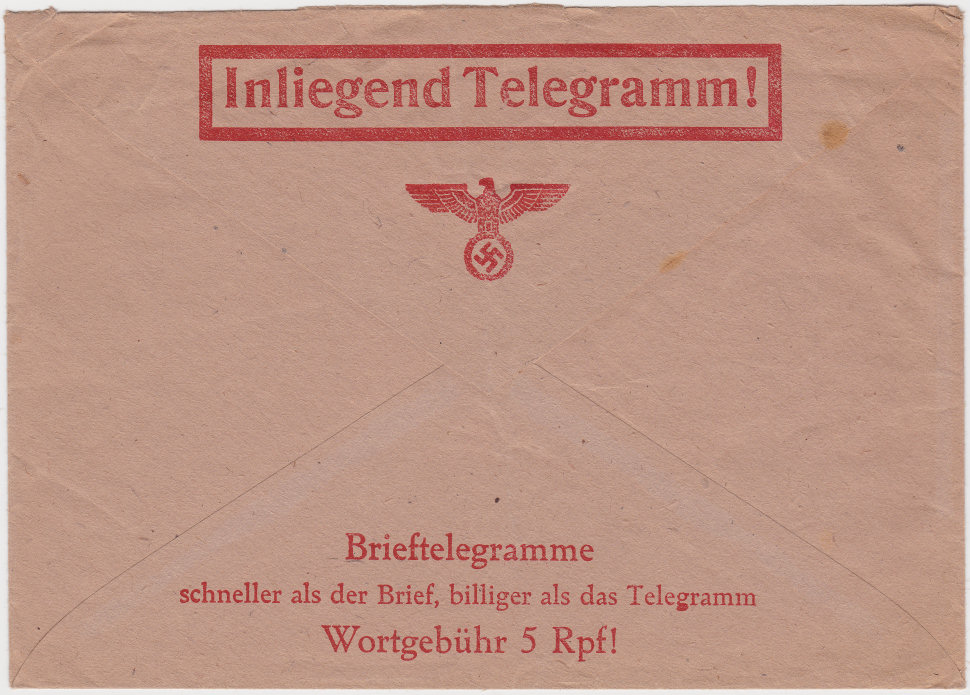
"A. M. L." November 1942


This (trimmed ?) envelope has a printing date of June 1947 maybe? (The use of Fractur suggests earlier since Hitler didn't like it).
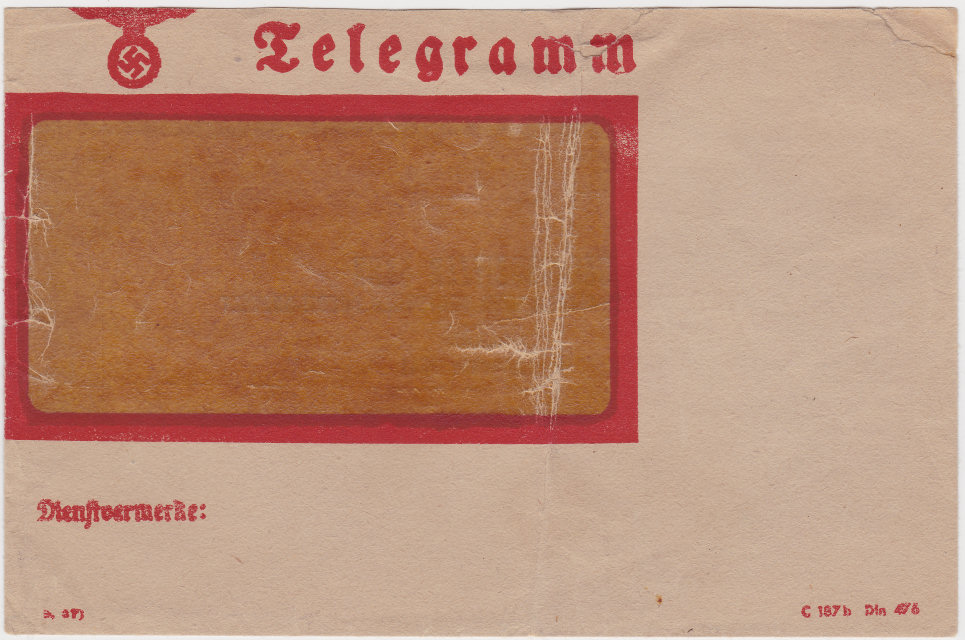

"?" "C 187 b" june 1947 ?


Similar envelope to last, but in black. Also has a printing date of June 1947 maybe? No image of back.
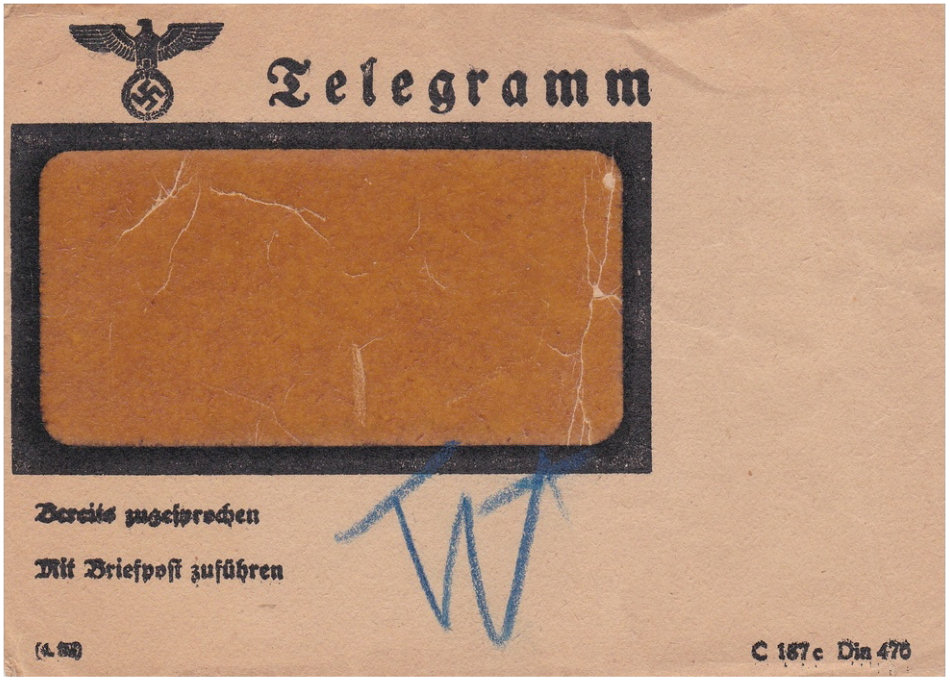
"?" june "C 187 c " 1947 ?


A bit of a gap here, help needed.
This envelope has a printing date of January 1952.
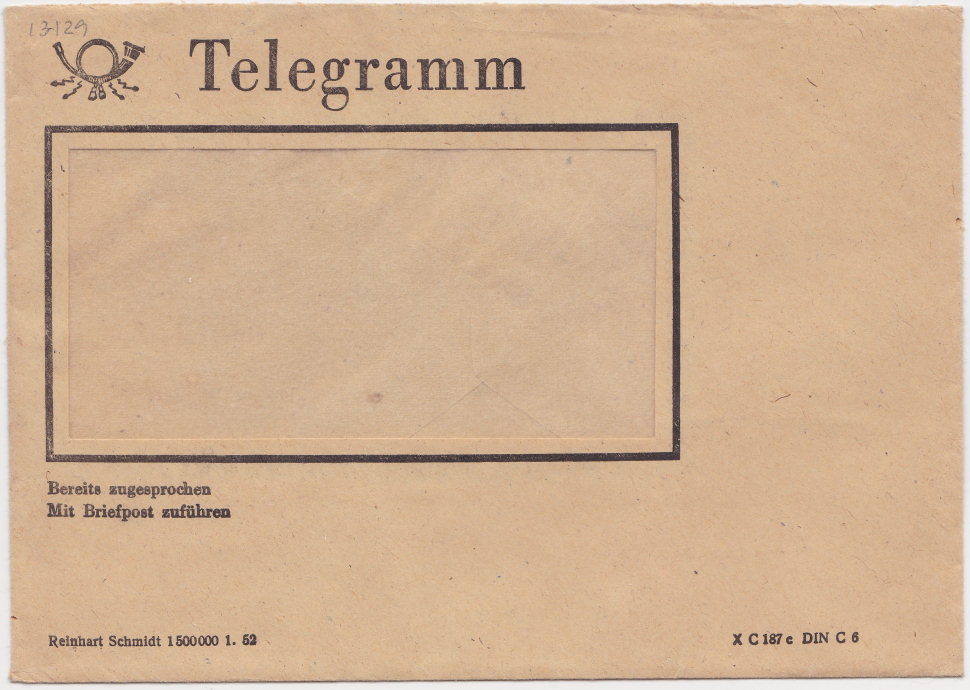
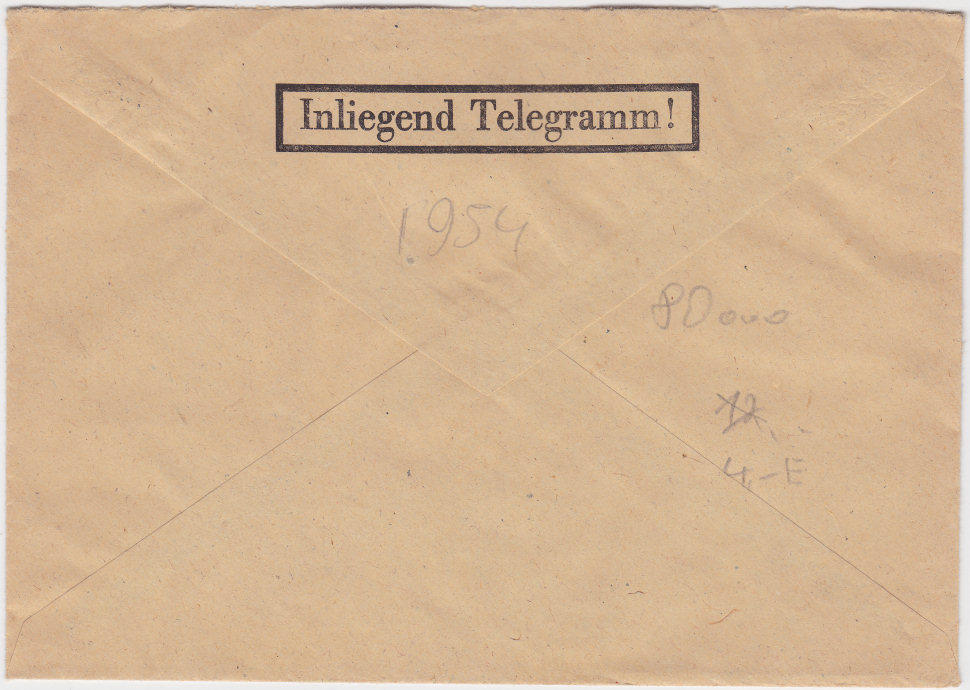
"Reinhart Schmidt, Wuppertal-E" The "E" perhaps stands for Elberfeld. A printing date of January 1952.
(Wuppertal is a city in North Rhine-Westphalia in the northwestern part of Germany. It was founded in 1929 out of the merger between the independent cities Barmen and Elberfeld.)
![]()
![]()
This envelope has a printing date of February 1959.

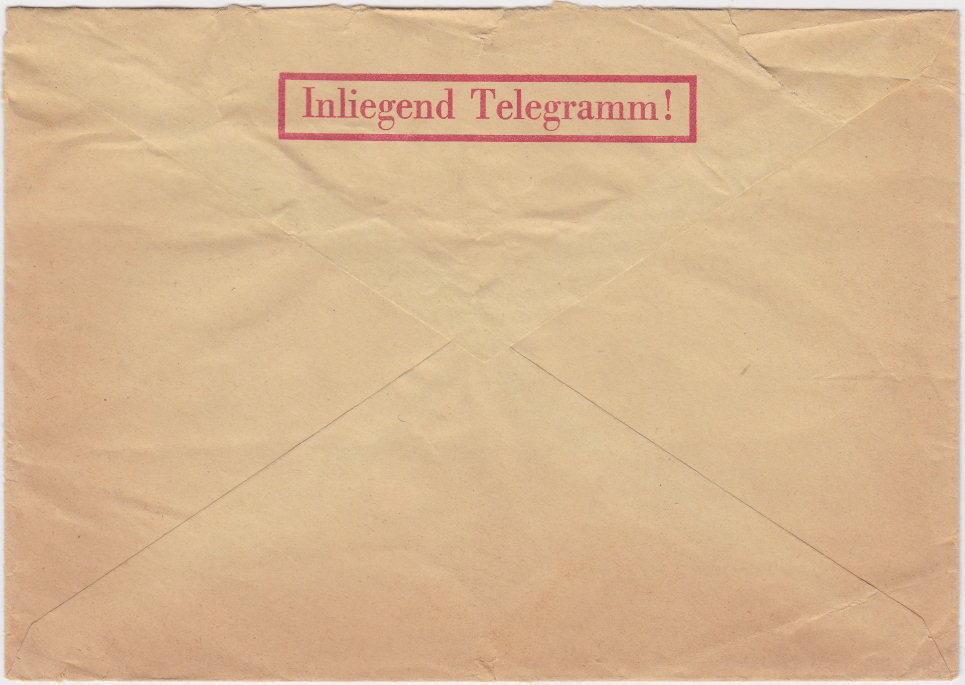
"Reinhart Schmidt, Wuppertal-E" The "E" perhaps stands for Elberfeld. A printing date of February 1959. Kl. 39f ?
![]()

This envelope has a printing date of February 1960.

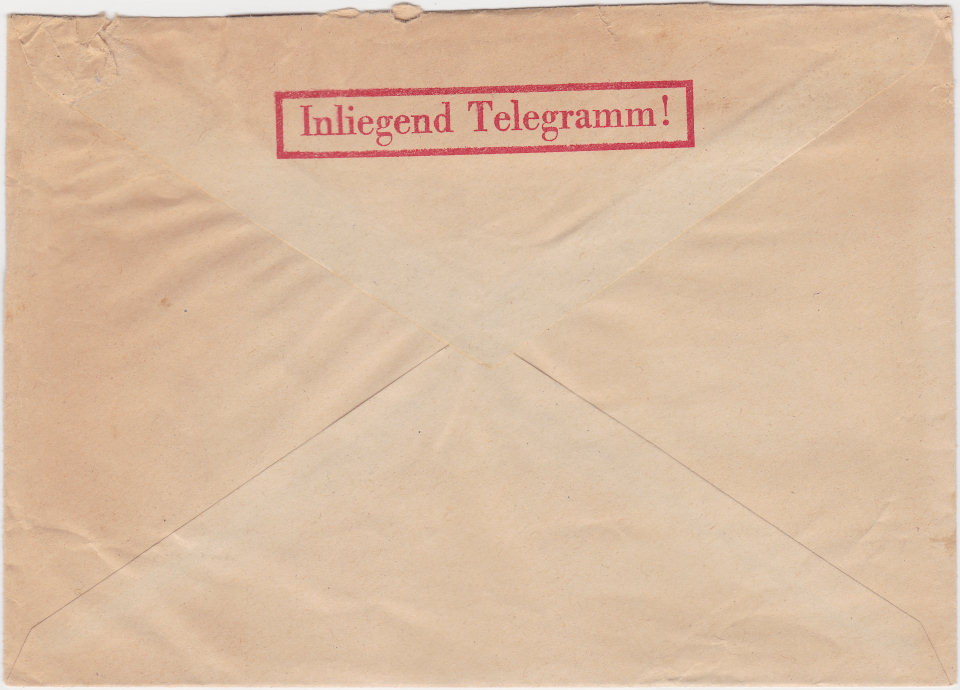
"Reinhart Schmidt, Wuppertal-E" The "E" perhaps stands for Elberfeld. A printing date of February 1960. Kl. 39f


This envelope, apparently used 28 March 1969(on the back), has a printing date of September 1963 (should that have been 68 ?).
It calls it a "Brieftelegramm".
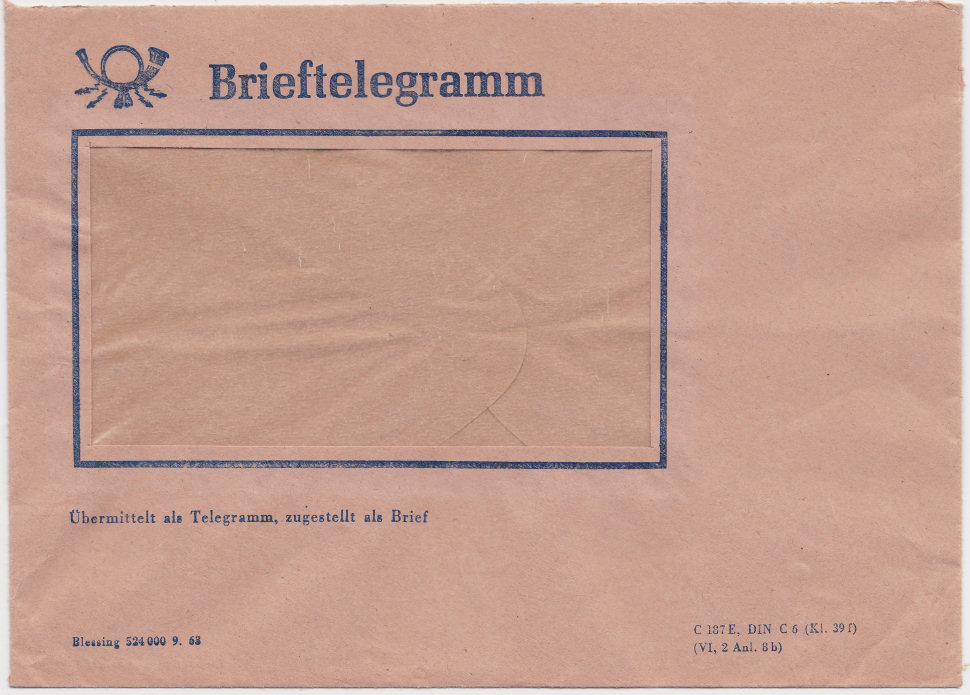

"Blessing". A printing date of September 1963 ? Kl. 39f


This envelope has a printing date of August 1967.
It contained a telegram dated 24 October 1967.


"Pflüger". A printing date of August 1967. Kl. 39f


This envelope has a printing date of February 1968.
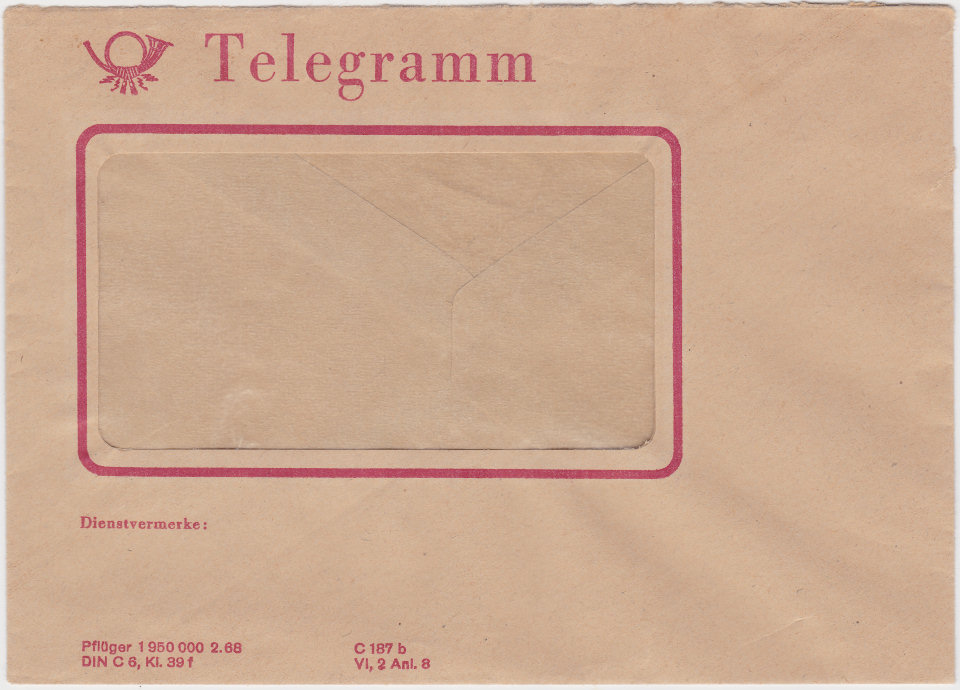

"Pflüger". A printing date of February 1968. Kl. 39f


This envelope has different dimensions to the others with much less height. No printing date.
It does not have date markings on the back like later ones. I would guess about 1970.
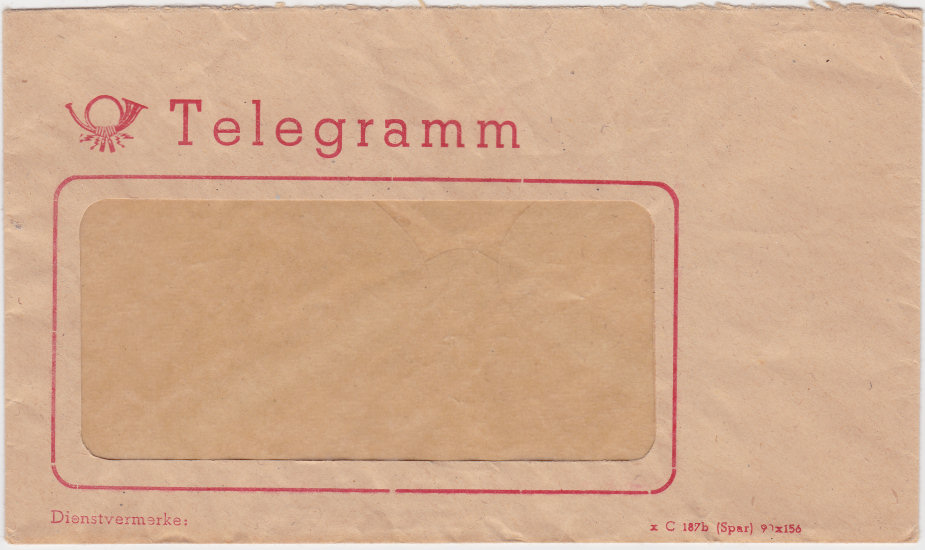

"Spar". No printing date, but dimensions.
![]()
This envelope used 12 June 1971 as marked on the back, has a printing date of February 1970.
Now called a Brieftelegramm.
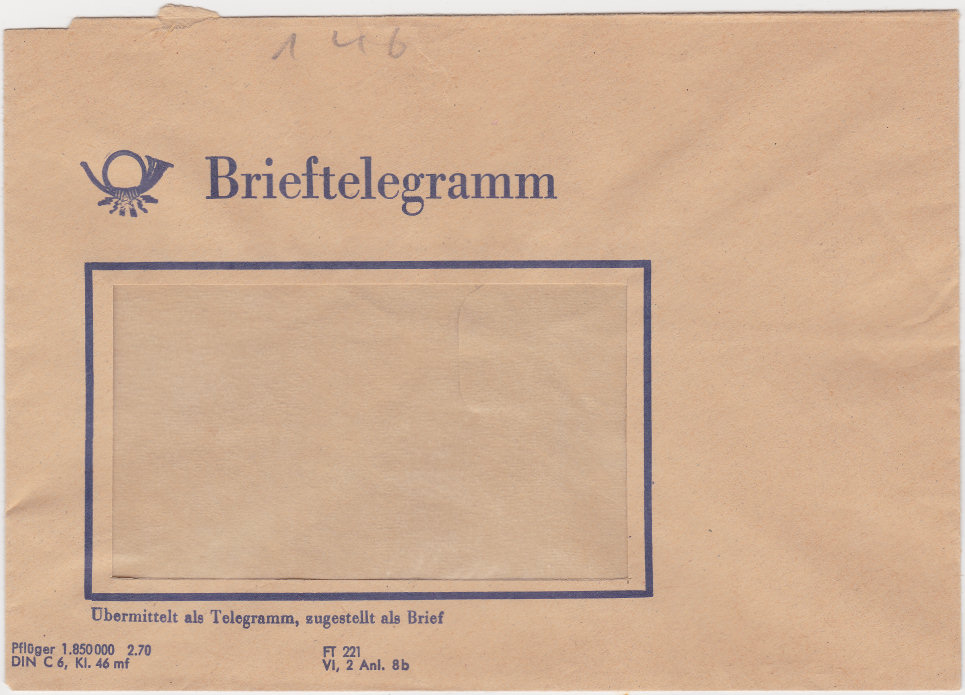

"Pflüger". A printing date of February 1970. Now Kl. 46mf


This envelope used 2 May 1973, has a printing date of September 1970.
Now back to a Telegramm.
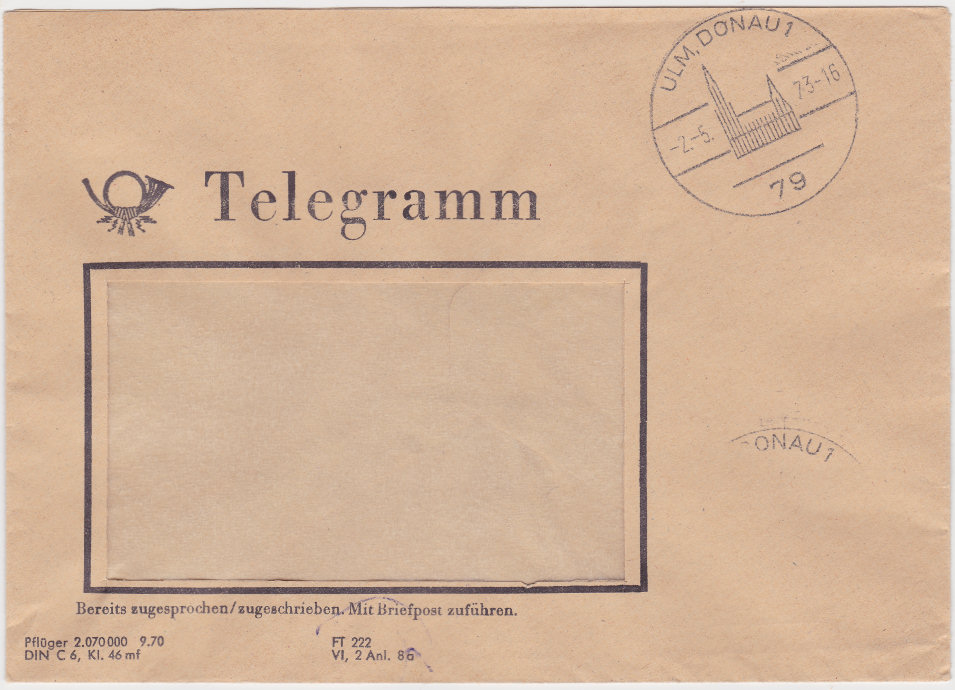

"Pflüger". A printing date of September 1970. Kl. 46mf


Envelope Type C5.
Large envelopes with poor quality Logo and nothing on the back.
This envelope, used 23 December 1977 has a printing date of October 1970.
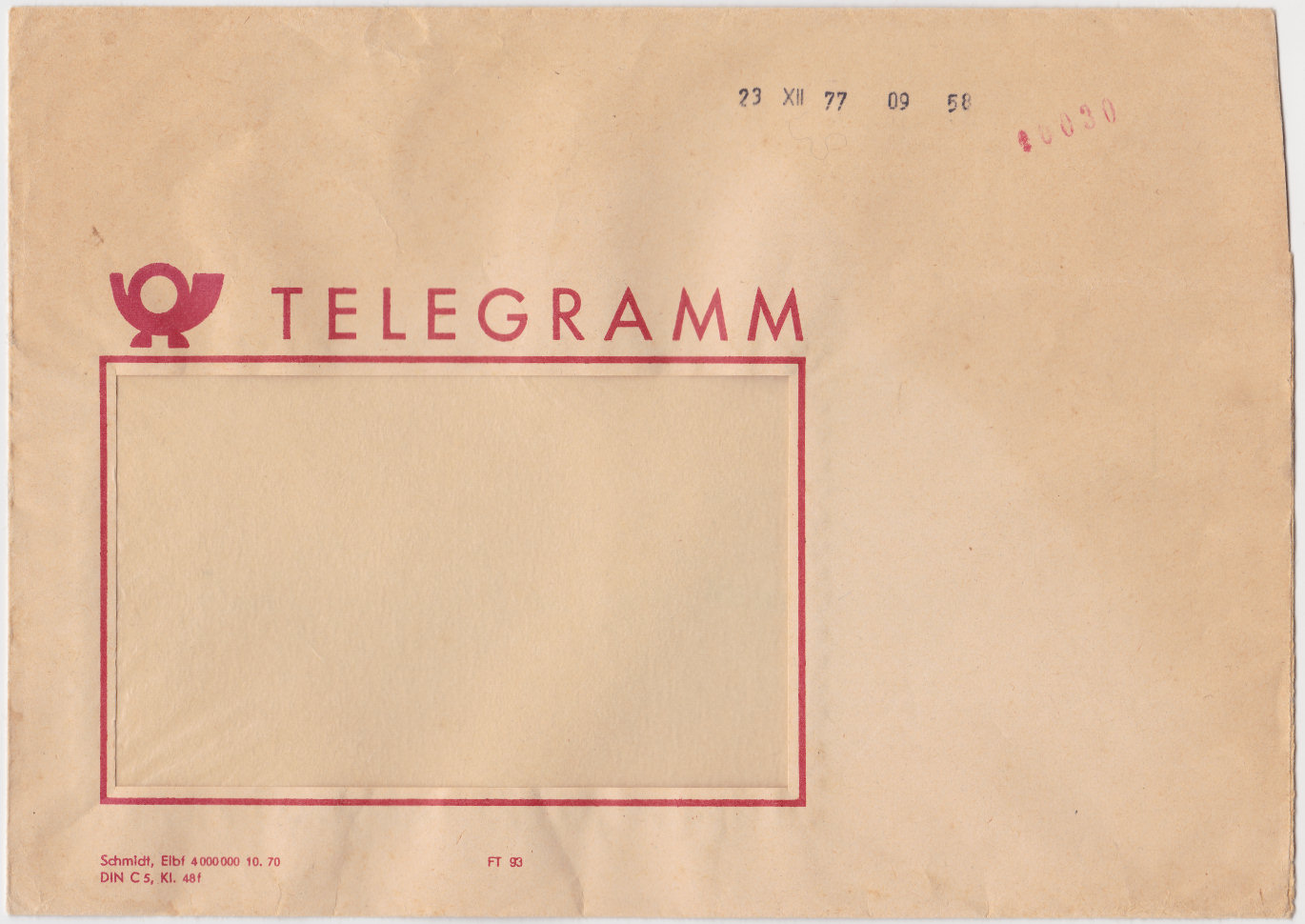
"Schmidt, Elbf" Printed October 1970. Kl. 48f


This envelope, has a printing date of October 1980.
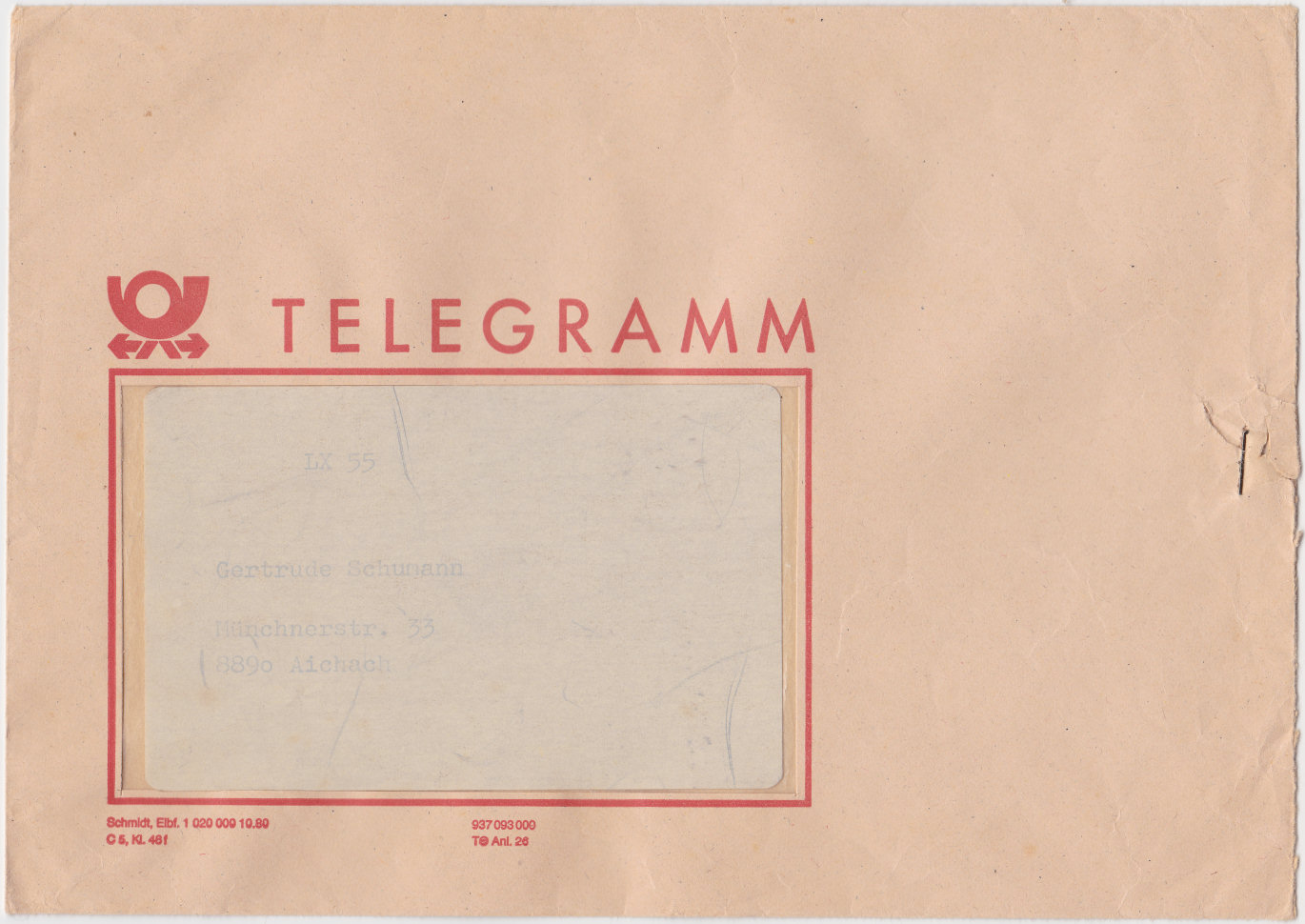
"Schmidt, Elbf" Printed October 1980. Kl. 48f


8. East Germany.
Form C183. An East German telegram bearing stamps dating from 1973.
The address is at the top, with the Coat of Arms below. Nothing on the back The telegram is folded and sealed for despatch.

The imprint gives no real clue of the printing date, but does the form number of C183.

The back has Service Notes.

Telegraph Seals.
A range of different seals were used on German telegrams at different times.
This half sized image shows a sample of them.
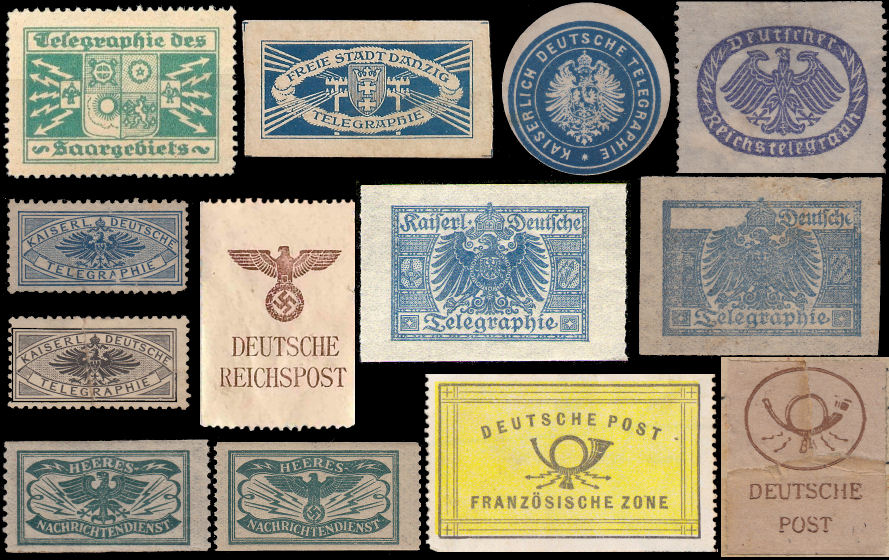
Steve Hiscocks made a start on cataloguing seals of the world in a book he published in 2007.
It was his hope to update it later, but unfortunately that was not to be.
His original book can be viewed at
Telegraph Seals: A World Catalogue. There are links from the pages to my updates.
Alternatively you can view the latest page for Germany which also shows a range of telegrams used.
